
The AMD Radeon RX 7600 XT is an advanced graphics card optimized for high-performance gaming at 1080p resolution and beyond. It is part of the Radeon RX 7000 series and is built on AMD’s RDNA 3 graphics architecture, featuring the Navi 33 GPU. This architecture is designed to cater to various market segments and performance targets.
Key specifications of the Radeon RX 7600 XT include 32 unified compute units, which are similar to those found in higher-end cards of the Radeon family. It also boasts AI and 2nd-generation ray tracing accelerators, a feature that enhances its performance in rendering and gaming applications. The card is equipped with an updated media engine that supports hardware AV1 encoding, along with the Radiance Display Engine that supports DisplayPort 2.1.
In terms of clock speeds, the Radeon RX 7600 XT offers boost clocks up to 2.755GHz and typical game clocks of around 2.470GHz. This results in higher compute performance and fill rates compared to previous-generation Radeon cards in its class. The Radeon RX 7600 XT comes with 32MB of second-gen Infinity Cache, providing an effective upgrade over its predecessors in terms of memory and power efficiency.
The PowerColor Hellhound Radeon RX 7600 XT variant includes a BIOS switch that allows users to toggle between overclocked and silent modes. In overclocked mode, the card targets a higher power of 165W, with a game clock of 2,539MHz and a boost clock of 2,810MHz. The silent mode, on the other hand, targets 150W power with slightly lower clock speeds. Both modes operate the 16GB of GDDR6 memory at an effective data rate of 18Gbps. The card also features a 9-phase power circuitry, providing extra power headroom for overclocking.
Regarding cooling, the PowerColor Hellhound Radeon RX 7600 XT is equipped with a dual-axial fan cooler, which effectively maintains temperature control while minimizing noise. The cooler consists of two 100mm axial, double-ball bearing fans sitting atop a large array of heatsink fins, and six heat pipes that converge directly above the GPU. An additional heat plate is also present to aid in cooling.
The PowerColor variant offers a unique display output configuration with three full-sized DisplayPorts (2.1) and a single HDMI port (2.1). It also features lighted fans with adjustable colors and modes for added customization.
The AMD Radeon RX 7600 XT is priced starting at around $330, making it a competitive option in its market segment, especially considering its performance upgrades over the RX 7600 and its capabilities compared to rival products like the RTX 4060 and Arc A770.
These features and specifications make the Radeon RX 7600 XT a compelling choice for gamers seeking high-quality gaming experiences at 1080p and beyond, with the added benefits of advanced technology and performance optimizations inherent in AMD’s latest graphics architecture.
AMD Radeon RX 7600 XT Review: Elevating 2K Gaming at $329
The AMD Radeon RX 7600 XT graphics card, a successor to the entry-level 1080p RX 7600, shares similar specifications but offers enhanced features for an improved gaming experience. Both models are built on the Navi 33 architecture, with 32 compute units (CUs), 2048 stream processors, and 32 RA units for ray tracing acceleration, complemented by 64 AI acceleration units. However, the RX 7600 XT stands out with its 16GB of GDDR6 memory, surpassing its predecessor’s memory capacity. It boasts a higher GPU Boost clock speed of 2755 MHz, contributing to better performance. This increase in power also results in a higher Total Board Power (TBP) of 190W, indicating a more robust energy requirement for the RX 7600 XT. These specifications position the Radeon RX 7600 XT as a potent option for gamers seeking enhanced performance in 1080p gaming environments.
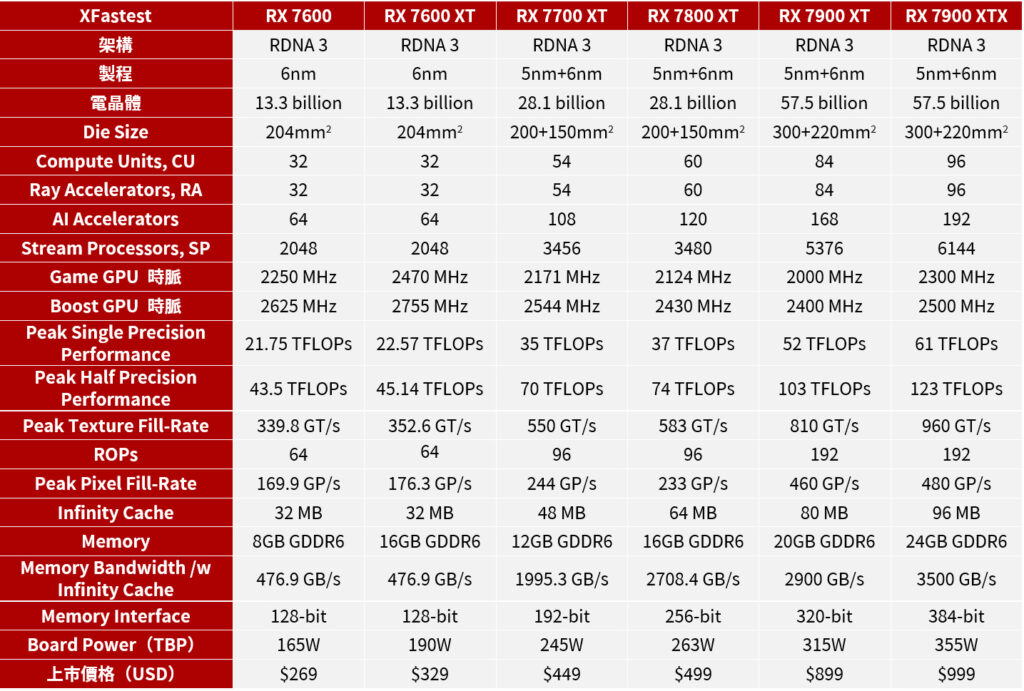
The AMD Radeon RX 7600 XT is a robust addition to the Radeon RX 7000 series lineup, engineered for gamers who demand high performance at 1080p resolution. Featuring the advanced RDNA 3 architecture and fabricated on a 6nm process, this GPU boasts 32 compute units and an equal number of ray accelerators, positioning it well for ray-traced graphics. It is equipped with 2048 stream processors, matched with 64 AI accelerators, providing a solid foundation for AI-enhanced gaming and tasks.
A significant upgrade in the RX 7600 XT is its memory configuration, with 16GB of GDDR6, double the amount of the standard RX 7600. This increase in memory, coupled with the same 128-bit memory interface, allows for a memory bandwidth of 476.9 GB/s when combined with the Infinity Cache, ensuring smooth frame rates and high-resolution textures.
The GPU clocks are notably higher in the RX 7600 XT, with a boost clock of 2755 MHz, which is a considerable improvement over the base model. This translates to peak single precision performance of 22.57 TFLOPs and peak texture fill rates of 352.6 GT/s. The card’s computing power is further illustrated by its 45.14 TFLOPs of half-precision performance, catering to compute-intensive applications.
The power requirements for the RX 7600 XT are higher, with a Total Board Power (TBP) of 190W, reflecting its enhanced performance capabilities. This positions the RX 7600 XT as a more powerful yet efficient choice for gamers and professionals alike, offering top-tier performance at a competitive price point of $329. With this configuration, the Radeon RX 7600 XT sets a new benchmark for mid-range GPUs, delivering high-fidelity gaming experiences without compromising on efficiency or value.
The AMD Radeon RX 7600 XT is aptly positioned as an entry-level 2K gaming graphics card, offering cutting-edge features at a starting price of USD 329. It supports ray tracing, and AI-enhanced graphics, and is equipped with AMD’s proprietary Hyper-RX technology, ensuring gamers can enjoy the latest advancements in gaming visuals. The RX 7600 XT is compatible with DisplayPort 2.1, providing high bandwidth for ultra-high resolutions and refresh rates. This GPU is available in various custom versions from multiple manufacturers, giving consumers a range of options to choose from based on their brand preference and specific performance enhancements.
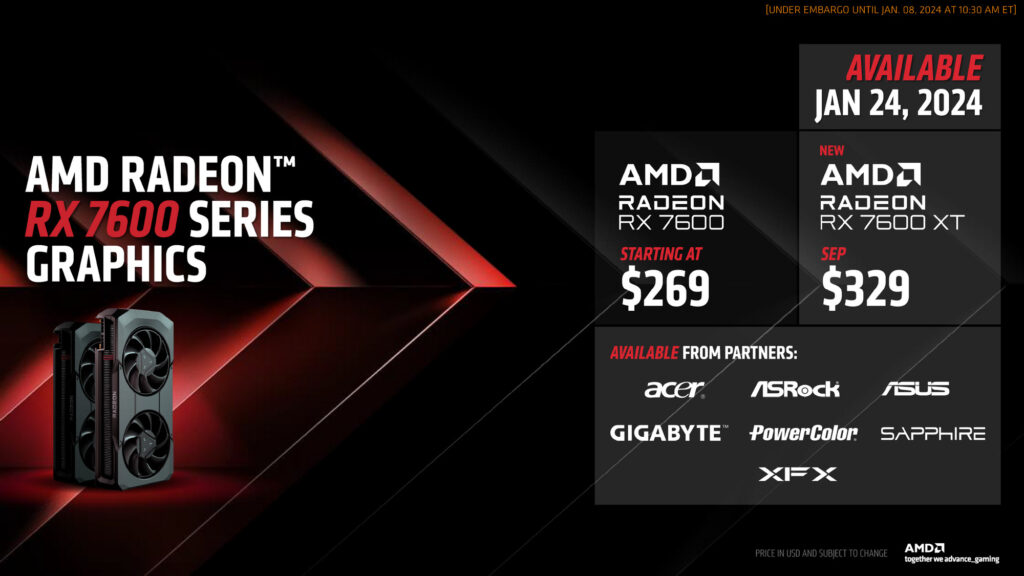
The AMD Radeon RX 7600 series graphics cards, with the new RX 7600 XT model prominently advertised at a starting price of USD 329. The release is marked as available from January 24, 2024, and the card is listed as being offered by a range of AMD’s partner brands, including Acer, ASRock, ASUS, GIGABYTE, PowerColor, SAPPHIRE, and XFX. This visual advertisement emphasizes the RX 7600 XT’s position within the market as a competitively priced hardware option for gamers looking to achieve high-performance gaming at 2K resolution. It is important to note the price is subject to change and is listed in USD.
ASUS TUF Gaming RX 7600 XT OC 16GB: Comprehensive Review and Performance Analysis
The ASUS TUF Gaming RX 7600 XT OC with 16GB of memory features an innovative cooling system utilizing three axial-tech fans, which include both standard and reverse rotation to enhance airflow through the heatsink. This cooling technology is paired with a substantial heatsink that spans 30 cm in length and occupies 2.96 slots, ensuring efficient heat dissipation. Furthermore, the graphics card incorporates a shortened PCB that works in tandem with high-durability power components and is reinforced with a metal backplate, providing the card with excellent cooling efficiency and robustness. This combination of cooling and durable construction is designed to maintain performance under heavy loads, making it a reliable choice for gamers and professionals who require sustained performance.
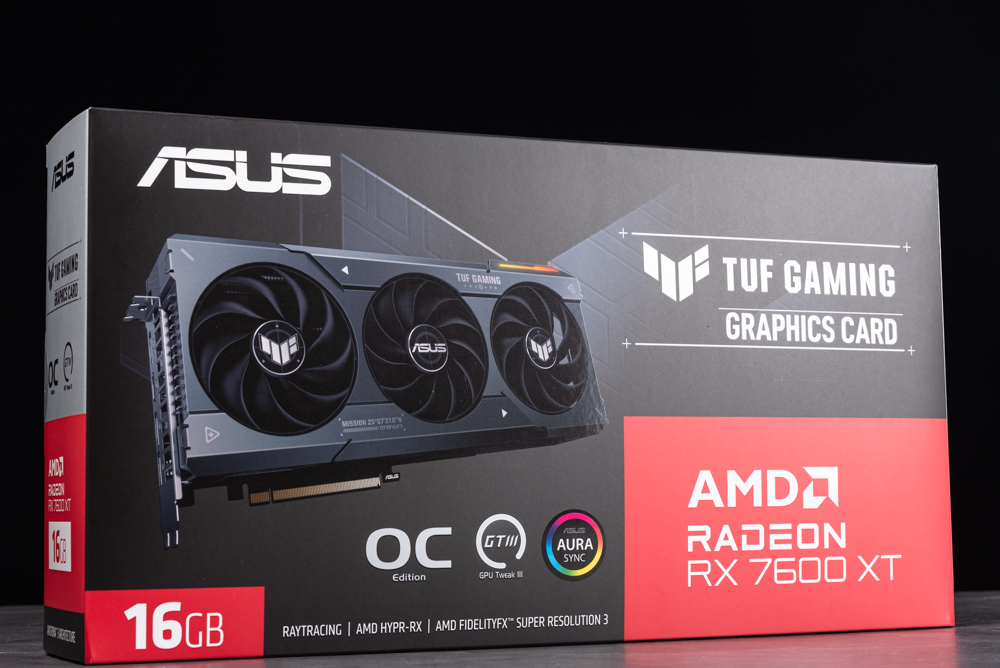
The retail packaging for the ASUS TUF Gaming RX 7600 XT OC with 16GB of memory. The box emphasizes the card’s robust gaming credentials, showcasing the TUF Gaming branding, which is associated with durability and performance. The packaging highlights several features such as overclocking (OC Edition), 16GB of video memory, ray tracing capabilities, AMD HYPR-RX technology, and FidelityFX Super Resolution 3. The ASUS Aura Sync compatibility is also noted, indicating that this card supports RGB lighting synchronization with other peripherals. The presentation of the packaging is designed to appeal to gamers looking for a high-performance, reliable graphics card upgrade.
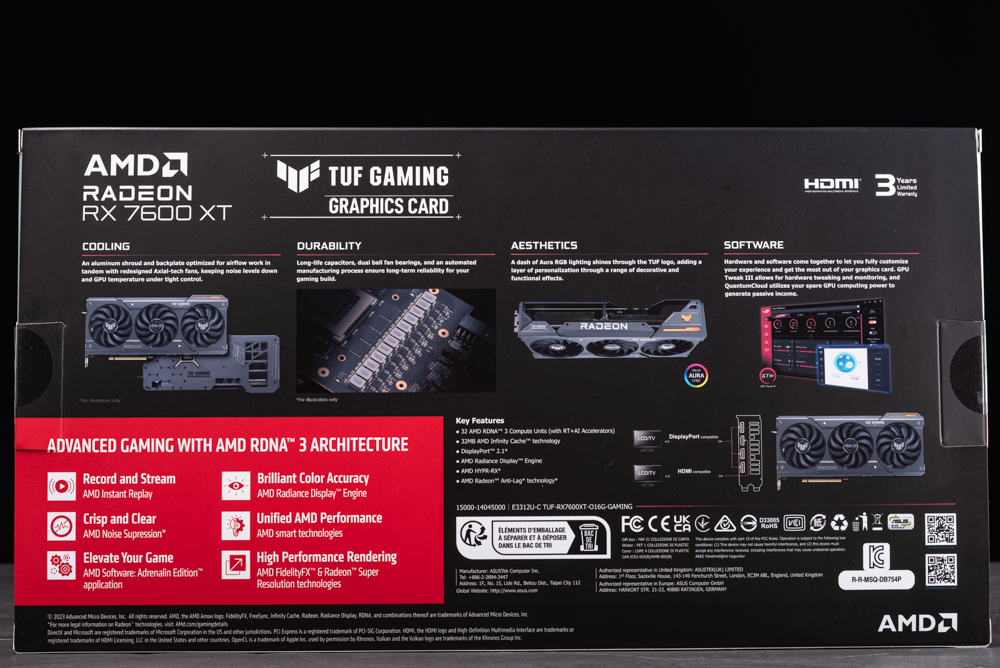
The backside of the ASUS TUF Gaming RX 7600 XT OC 16GB graphics card packaging highlights several key features across different categories:
Cooling: It details an advanced and adaptable cooling system that is optimized for quieter work in high-temperature and high-load scenarios. This ensures the GPU operates efficiently without overheating, contributing to consistent gaming performance.
Durability: Emphasizing long-lasting components, dual ball fan bearings, and an automated manufacturing process, the card is designed to enhance reliability for gaming builds.
Aesthetics: The packaging points out the TUF Gaming card’s aesthetic appeal, featuring Aura RGB lighting that adds a touch of decorative and functional effects.
Software: The integration of hardware and software is designed to allow full customization and optimized performance. Tools like GPU Tweak III facilitate fine-tuning of the graphics card, and QuantumCloud offers a means to utilize GPU computing power to potentially generate passive income.
The packaging also underlines the card’s use of AMD RDNA™ 3 architecture, mentioning features like AMD Instant Replay for capturing gameplay, AMD Noise Suppression for clearer audio, and high-performance rendering with AMD FidelityFX™ and Radeon™ Super Resolution technologies. The emphasis is on delivering an advanced gaming experience with brilliant color accuracy, unified AMD performance, and software technologies that elevate the gaming experience.
The box indicates a three-year warranty, reassuring buyers of support and service over an extended period. This comprehensive presentation of features caters to gamers and enthusiasts who value performance, stability, and visual appeal in their hardware choices.
The TUF Gaming RX 7600 XT OC 16GB graphics card upholds the TUF series’ reputation for rugged, reliable construction. It has dimensions of 300.2 x 142.75 x 59.2 mm, occupying 2.96 slots within a computer case. This model employs a trio of axial-tech fans, which are designed with a smaller hub that allows for longer blades, increasing airflow.
The innovative fan design, where the outer fans spin in reverse and the central fan spins in the traditional direction, creates a more complex airflow pattern that enhances the cooling efficiency across the heatsink. This fan configuration is optimized to deliver improved heat dissipation, ensuring that the card remains cool even under intense gaming or workload conditions. This attention to cooling detail is a hallmark of the TUF brand, which is known for creating products that are not only high-performing but also durable and long-lasting.
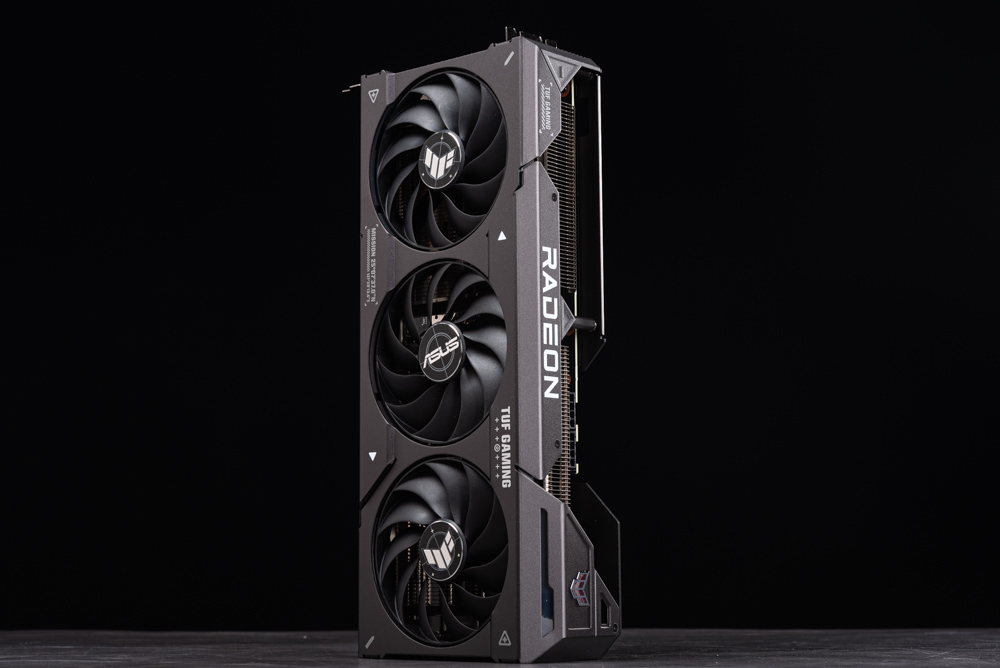
The ASUS TUF Gaming RX 7600 XT OC 16GB graphics card, showcases its robust and formidable design. The card features three large axial-tech fans which are engineered for enhanced airflow, with the alternating spin directions of the fans designed to increase air pressure and improve cooling efficiency across the heatsink. This model’s visual aesthetic is characterized by a strong, angular design with the TUF Gaming and Radeon logos prominently displayed, signifying its gaming and performance pedigree.
The card’s structure, with its substantial size and slot occupancy, signifies a build that is intended to handle the demands of high-performance gaming and prolonged use. The attention to detail in the cooling system design is apparent, signifying that it is built to maintain performance while minimizing thermal thresholds during intense gaming sessions. The TUF Gaming RX 7600 XT OC is a testament to ASUS’s commitment to quality and durability in its gaming products.
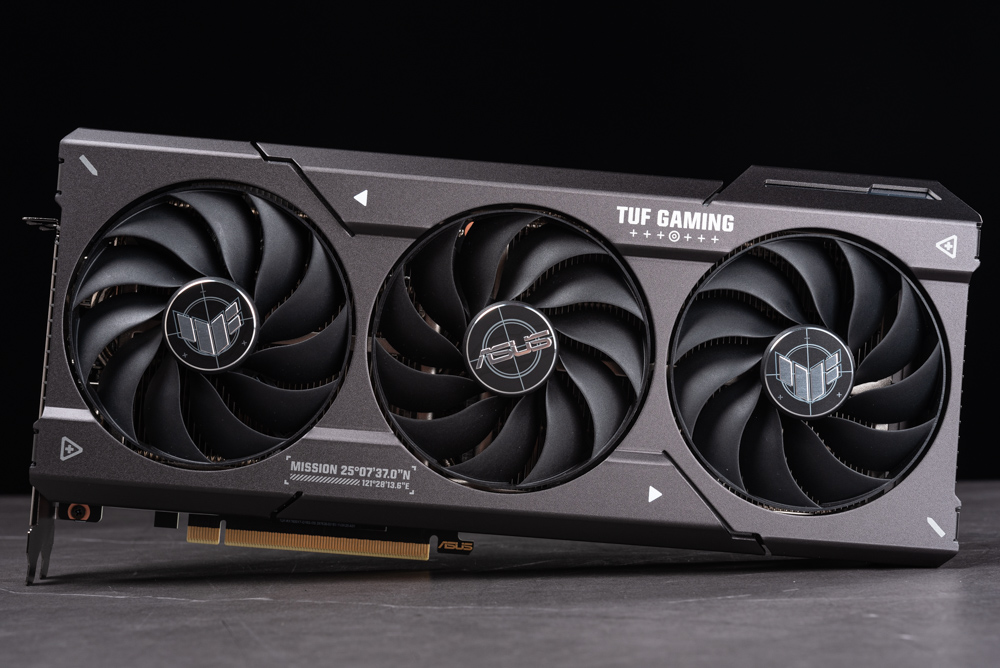
The ASUS TUF Gaming RX 7600 XT OC 16GB graphics card, highlights its trio of axial-tech fans. The design of these fans is particularly noteworthy for their alternating rotational directions, which is an innovative approach to optimizing airflow and enhancing cooling efficiency across the card’s heatsink. This design choice is instrumental in managing the thermals of the high-performance components housed within the card.
The axial-tech fan design, with its smaller fan hub that allows for longer blades, can move more air through the heatsink efficiently and quietly. The combination of the fans’ rotation pattern and the extended blade size ensures that cool air is delivered directly to the GPU die, helping to maintain lower temperatures even under load.
The photo captures the intricate details of the fan blades and the sturdy construction of the card, emphasizing the TUF Gaming brand’s commitment to quality, durability, and performance. The visual presentation of the card, with the TUF Gaming branding and angular, geometric accents, communicates a sense of reliability and strength, which is characteristic of ASUS’s TUF series products.
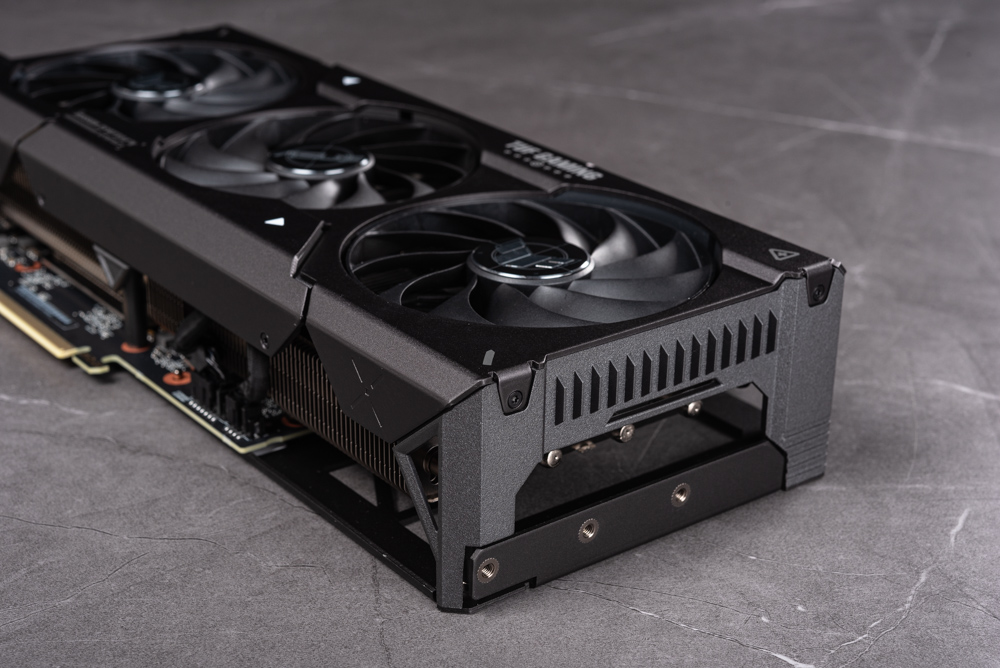
A close-up view of the ASUS TUF Gaming RX 7600 XT OC 16GB graphics card from an angle that highlights the protective shroud towards the front end. The shroud’s design is robust, featuring angular contours and vent-like cutouts that complement the overall TUF aesthetic known for its focus on durability and toughness. This structural design not only adds to the visual appeal but also serves a functional purpose, contributing to the card’s structural integrity and providing protection for the underlying components.
The visible heat sink fins beneath the shroud indicate the card’s extensive cooling system designed to manage heat efficiently. The attention to detail in the construction suggests that the card is built to withstand the thermal demands of high-performance gaming. The protective shroud is part of the card’s comprehensive cooling solution, which includes the axial-tech fans, to ensure optimal performance during intensive computing tasks.
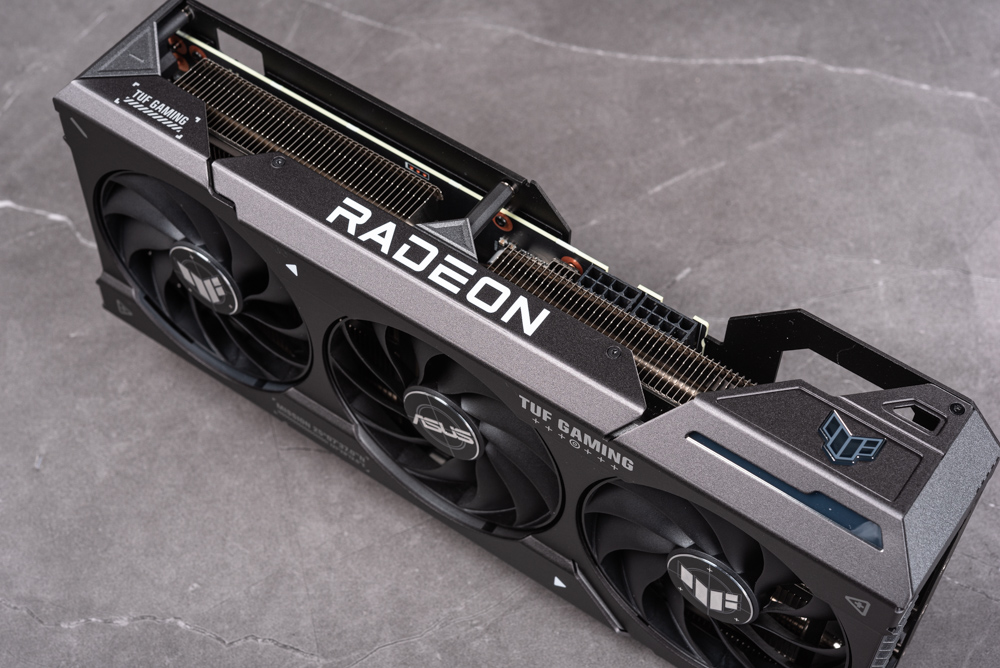
A clear view of the upper side of the ASUS TUF Gaming RX 7600 XT OC 16GB graphics card, highlighting some of its most distinctive features. Prominently displayed is the large ‘RADEON’ branding, indicative of the card’s AMD Radeon GPU lineage, which is known for its high performance in gaming and computing tasks. Accompanying this is the TUF Gaming logo, which is equipped with RGB lighting capabilities, adding to the visual appeal of the card when installed in a system with a windowed case.
The card requires two PCIe 8-pin power connectors, and it is recommended to be paired with a power supply unit (PSU) that provides 600W or more to ensure sufficient power delivery for stable operation. This power configuration, with a TBP (Total Board Power) of 190W, is a testament to the card’s high-performance capabilities.
Furthermore, the card features a smart power indicator on the back. When the card is installed on the motherboard and the system is powered on, if the PCIe 8-pin power connectors are not properly connected, a red indicator light will illuminate. This serves as a visual alert for users to ensure that the card’s power connections are secure, preventing potential issues related to insufficient power delivery.
The design and functionality, as shown in the image, reflect a product that is both user-friendly and performance-oriented, catering to the needs of serious gamers and professionals who demand reliability and high-quality construction from their hardware.
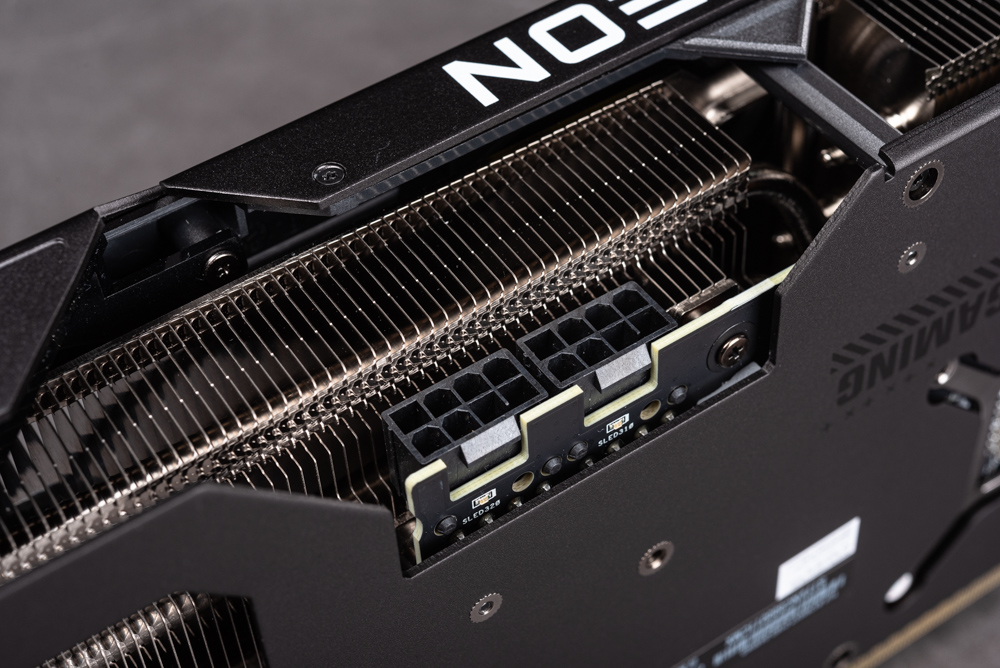
The power connector section of the ASUS TUF Gaming RX 7600 XT OC 16GB graphics card, where two PCIe 8-pin connectors are visible. This setup is designed to provide the necessary power for the card to perform optimally, especially under high-load conditions, such as during intense gaming sessions or demanding computing tasks.
The connectors are part of the card’s power delivery system, ensuring a stable and reliable power supply to the card’s components. The positioning and build quality of the connectors appear robust, aligning with the TUF Gaming series’ reputation for durable and long-lasting hardware.
The photo also shows a glimpse of the heat sink fins, indicative of the card’s comprehensive cooling solution to handle the thermal output effectively. The design and arrangement of the power connectors are user-friendly, allowing for easy and secure attachment of power cables from the PSU.
Having dual 8-pin connectors typically indicates that the card is targeted towards the higher end of the performance spectrum, capable of delivering the power needed for advanced features such as overclocking, ray tracing, and high-resolution gaming. This power configuration, along with the detailed view of the card’s construction, reinforces the high-quality standards that ASUS maintains for its gaming hardware.

The power connection area of the ASUS TUF Gaming RX 7600 XT OC 16GB graphics card, with a key detail being the illuminated power indicator lights. These red LEDs serve as a diagnostic feature; when lit, they indicate that the PCIe power connectors are either not connected or not properly secured. This is an important safety and convenience feature that can prevent users from running the card without proper power, which could lead to performance issues or damage.
The presence of these indicators is a testament to the thoughtful design and user-centric approach taken by ASUS in the development of their TUF Gaming series. By providing immediate visual feedback on the power connection status, users can quickly resolve any power connection issues before they start using their system, ensuring a reliable and stable operation of the graphics card.
This image also gives a sense of the card’s overall build quality, with a close-up view of the heatsink fins and the robust construction of the card’s casing, reinforcing the durable and high-performance nature of the TUF Gaming product line.
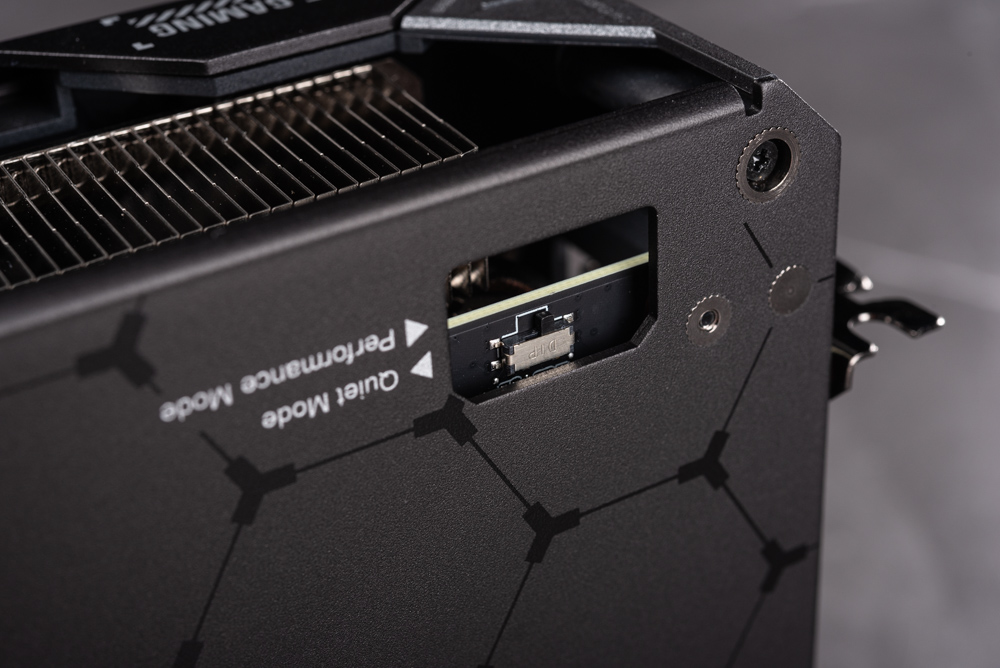
A close-up of the side of the ASUS TUF Gaming RX 7600 XT OC 16GB graphics card, where a dual BIOS switch is present. This switch allows users to toggle between two different firmware settings. The default setting is on “Performance” mode, which optimizes the card’s operation for the best gaming performance, typically allowing for higher clock speeds and more aggressive fan curves to handle the increased thermal output.
The presence of a dual BIOS is a feature valued by enthusiasts and professional users, as it provides an extra layer of customization and a safety net. If one BIOS configuration encounters issues, such as during an unstable overclocking attempt, the user can switch to the second BIOS to recover the card’s functionality without needing to re-flash the firmware.
This small, yet significant feature adds to the card’s versatility and reliability, making it a more attractive option for users who want to push their hardware to the limit or require a stable backup in case of any issues. It also underscores the TUF Gaming series’ commitment to providing durable, high-performance hardware that caters to the needs of serious gamers and overclocking enthusiasts.
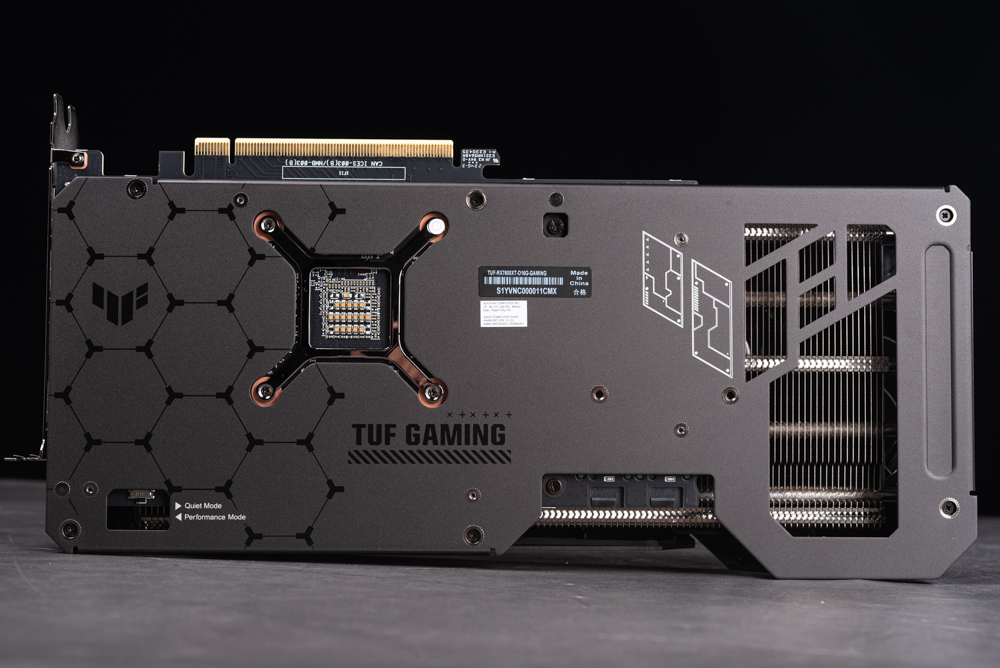
The ASUS TUF Gaming RX 7600 XT OC 16GB graphics card from a perspective that shows off its shorter PCB design and the extended metal backplate. This design choice offers several advantages:
- The shorter PCB reduces the potential for circuit board flexing, which can protect against physical stress and potential damage during installation or while in use.
- The space created by this shorter PCB design, combined with the venting holes in the backplate, allows for improved airflow. This is especially beneficial when the card is mounted horizontally, as it can enhance the cooling efficiency by allowing air to pass through more freely, thus aiding in the dissipation of heat.
The metal backplate adds rigidity to the card, further reducing the risk of bending and providing an additional layer of protection for the components on the PCB. It also contributes to the card’s overall aesthetic, with the TUF Gaming logo and the copper-colored accents around the mounting screws providing a distinctive look that complements the card’s high-performance credentials.
The image also shows the labeled switch for toggling between Quiet and Performance modes, giving users control over the card’s operating parameters based on their preference for noise levels or performance.
Overall, the design of the card reflects a balance between form and function, ensuring durability, enhanced cooling, and a visually appealing product that resonates with gamers and PC builders who are looking for top-tier hardware.
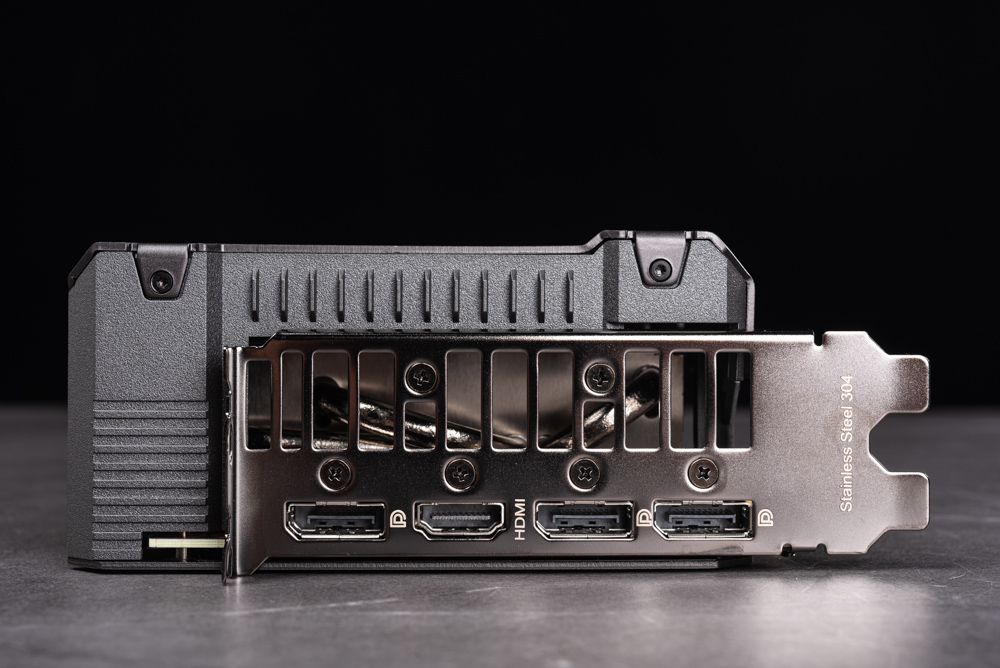
The ASUS TUF Gaming RX 7600 XT OC 16GB graphics card, which includes a variety of modern connectivity options to support multiple display setups. Specifically, the card offers one HDMI 2.1 port and three DisplayPort 2.1 ports, allowing users to connect up to four external monitors simultaneously.
The HDMI 2.1 port is designed to support higher resolutions and refresh rates, including 4K at 120Hz or 8K at 60Hz, along with features such as variable refresh rate (VRR), which is beneficial for gaming. The DisplayPort 2.1 connections also support high-resolution displays and can drive monitors with even higher refresh rates, making this card suitable for advanced gaming setups, professional workstations requiring detailed visuals, or immersive entertainment systems.
In addition to the ports, the bracket of the card is constructed from stainless steel 304, which is known for its durability and corrosion resistance. This quality material choice adds to the overall ruggedness of the card and ensures longevity, even in environments with variable temperatures and conditions.
The combination of high-quality construction and versatile display connectivity options makes this graphics card a robust choice for users looking to build a high-performance PC setup.
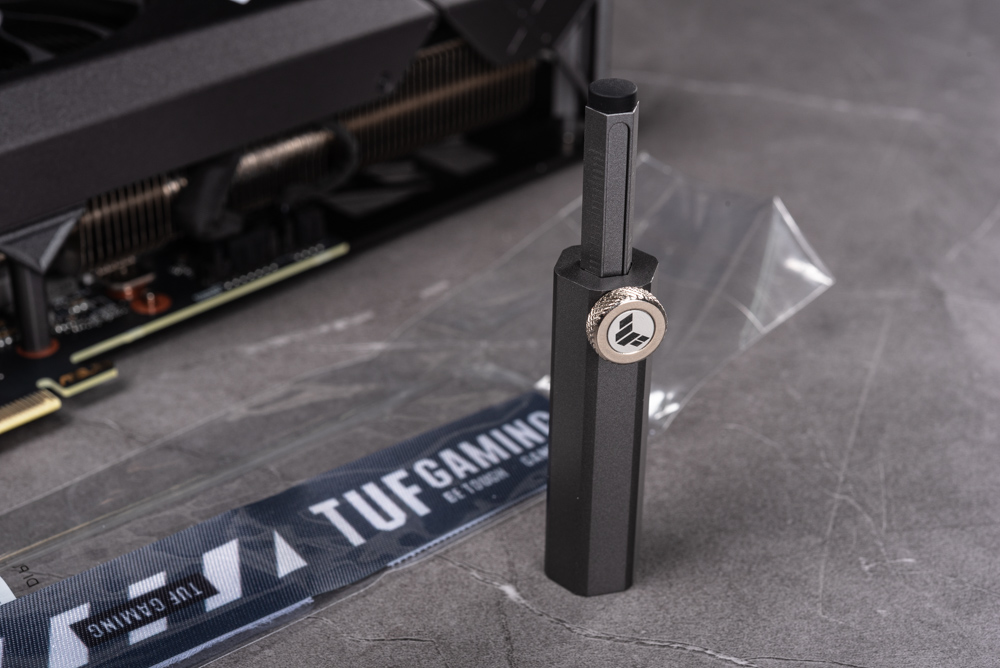
Showcasing the accessories that come with the ASUS TUF Gaming RX 7600 XT OC 16GB graphics card – a simple but practical TUF-branded graphics card support bracket, also known as a GPU brace or jack. This tool is designed to provide additional support to the graphics card when mounted horizontally in a PC case, helping to prevent sagging over time due to gravity, which can cause strain on the motherboard’s PCIe slot.
The dual-functionality of the support bracket is a thoughtful touch, with one end serving as a support stand for the GPU, and the other end featuring a Phillips-head screwdriver, which is useful for assembling or disassembling parts of the PC, such as M.2 heatsink screws.
This inclusion reflects ASUS’s commitment to durability and user convenience, ensuring that not only is the graphics card itself built to TUF standards, but also that the user has the right tools to maintain the integrity of their system. The support bracket is a testament to the comprehensive nature of ASUS’s TUF Gaming ecosystem, providing gamers and PC builders with the necessary accessories for a secure and long-lasting build.
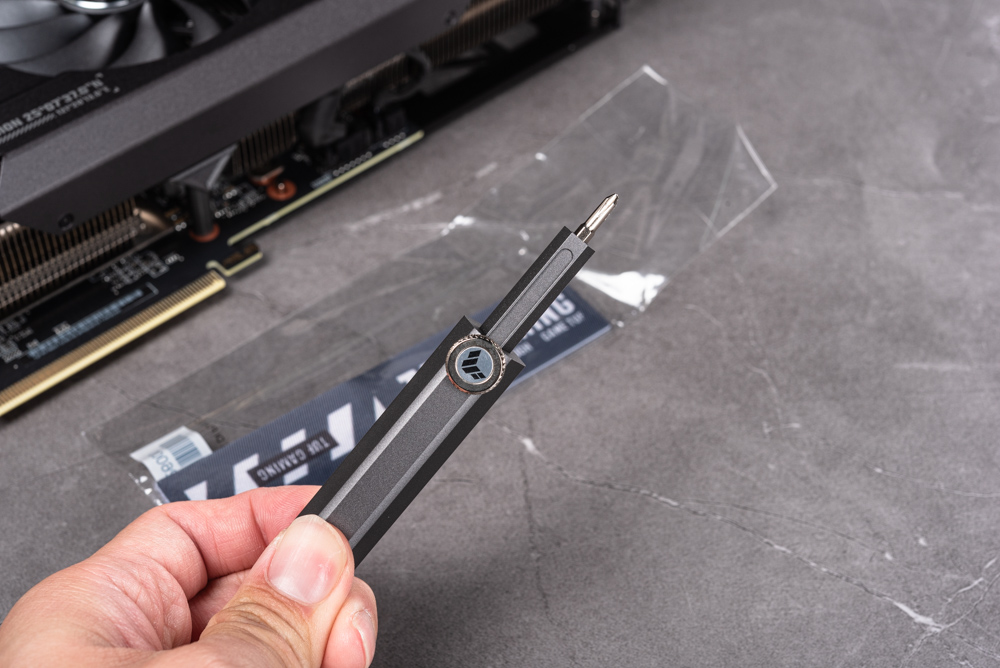
The other end of the TUF-branded graphics card support bracket doubles as a Phillips-head screwdriver. This clever design is particularly useful for PC builders, as it provides a tool for assembling or disassembling parts such as M.2 heatsink screws or other components within the PC that require such a screwdriver.
The screwdriver appears to be conveniently integrated into the support stand, making it easily accessible during the PC building or upgrading process. The tool’s dual functionality highlights ASUS’s attention to detail and consideration for the user experience, ensuring that the essentials for installation and maintenance are at hand. This practical approach to design underscores the TUF Gaming series’ focus on providing durable, user-friendly solutions for gamers and system builders.
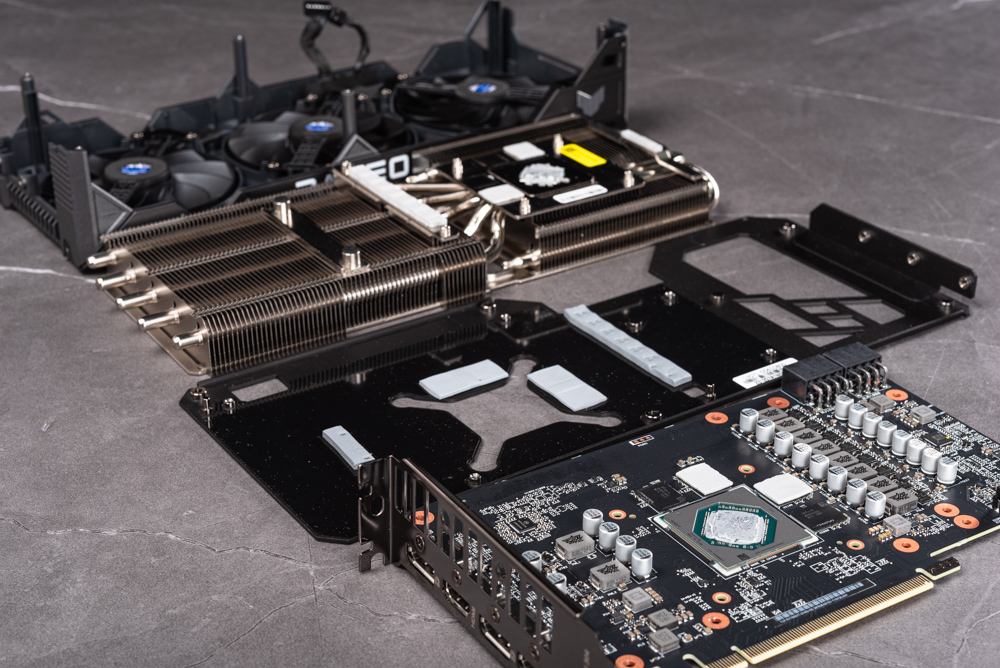
A disassembled ASUS TUF Gaming RX 7600 XT OC 16GB graphics card, revealing its internal components and the design approach taken to ensure durability and effective cooling.
Key observations include:
- Fan and Heatsink Design: The cooling solution is modular, with the fan shroud being separate from the heatsink. This separation can facilitate easier cleaning and maintenance, as well as potentially simpler repairs or replacements of the cooling components.
- PCB and Backplate: The printed circuit board (PCB) and the metal backplate are securely fastened together with screws, which adds structural rigidity to the card and helps protect against physical damage or warping.
- Heatsink Mounting: The heatsink is primarily mounted onto the PCB, which is a typical design choice to ensure the heat generated by the GPU die is efficiently absorbed and dissipated.
- Overall Assembly: The fan shroud, backplate, and PCIe bracket are all fixed with one another to ensure the card maintains a certain level of sturdiness.
This disassembled view showcases the TUF Gaming series’ emphasis on build quality and thermal management. The design is intentional to ensure that all parts contribute to the overall stability and cooling efficiency of the card, which is crucial for maintaining performance during heavy loads and extended usage. It also reflects the user-friendly aspect of TUF products, considering that the modular design can make user servicing and part replacement more accessible.
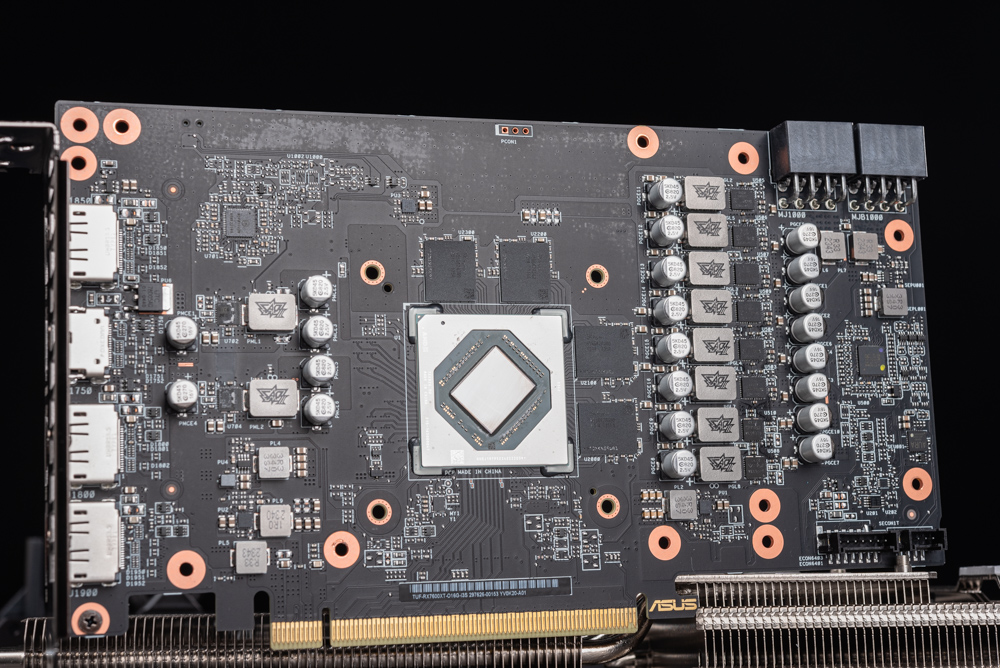
A detailed view of the PCB for the ASUS TUF Gaming RX 7600 XT OC 16GB graphics card. The card’s circuitry is noted for its neat and orderly component arrangement, which is a result of the automated manufacturing processes utilized in its production. This level of precision in component placement not only contributes to the aesthetic of the card but also ensures a reliable electrical connection and minimizes potential interference between components.
Featured centrally on the PCB is the Navi 33 GPU chip, which is the powerhouse behind the card’s graphics processing capabilities. Surrounding the GPU, the memory chips are arranged on both sides of the PCB, totaling eight in number, which together provide 16GB of GDDR6 memory. This memory configuration is essential for high-resolution gaming and demanding tasks that require a large amount of fast-access video memory.
The use of automated assembly for the PCB reflects modern manufacturing standards that prioritize consistency, efficiency, and quality. It also demonstrates ASUS’s commitment to precision engineering and reliability in their TUF Gaming series, providing users with a robust and high-performing gaming experience. The well-organized layout of the PCB, along with the high-quality components, underscores the card’s design for stability and longevity.
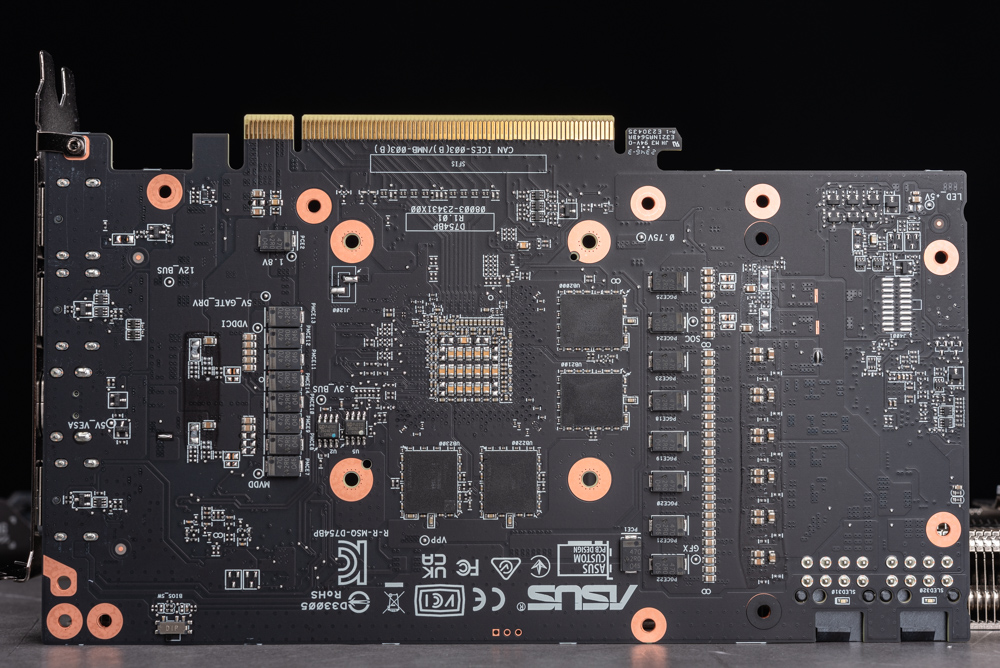
The back side of the PCB for the ASUS TUF Gaming RX 7600 XT OC 16GB graphics card. This view provides insight into the layout and design considerations taken to ensure the card’s functionality and durability.
Here are a few observations:
- Clean Layout: The back of the PCB is free of clutter, with a clear and organized arrangement of components, which is a testament to the high-quality manufacturing process ASUS employs.
- Copper Vias: The PCB features numerous copper-colored vias, which are small plated-through holes that connect the traces from one side of the PCB to the other. The use of copper is indicative of good quality as it enhances the PCB’s electrical and thermal performance.
- Power Delivery Components: We can see an array of components that are likely part of the power delivery network for the GPU and memory. These components are crucial in providing stable and efficient power to the card’s critical components.
- Protective Coating: The back of the PCB seems to have a protective coating, which is common in high-quality electronics. This coating helps to protect the board from dust, moisture, and potential short circuits.
- Identification and Traceability: There are various barcodes, serial numbers, and quality assurance marks, which are used for inventory and tracking during manufacturing and for post-sale support.
- Structural Reinforcement: The presence of screw holes with copper reinforcements suggests areas where the PCB is secured to the cooling system and backplate, adding to the overall structural integrity of the card.
The design elements visible here reflect ASUS’s commitment to quality and attention to detail, ensuring that their TUF series graphics cards are not only powerful but also reliable and built to last.
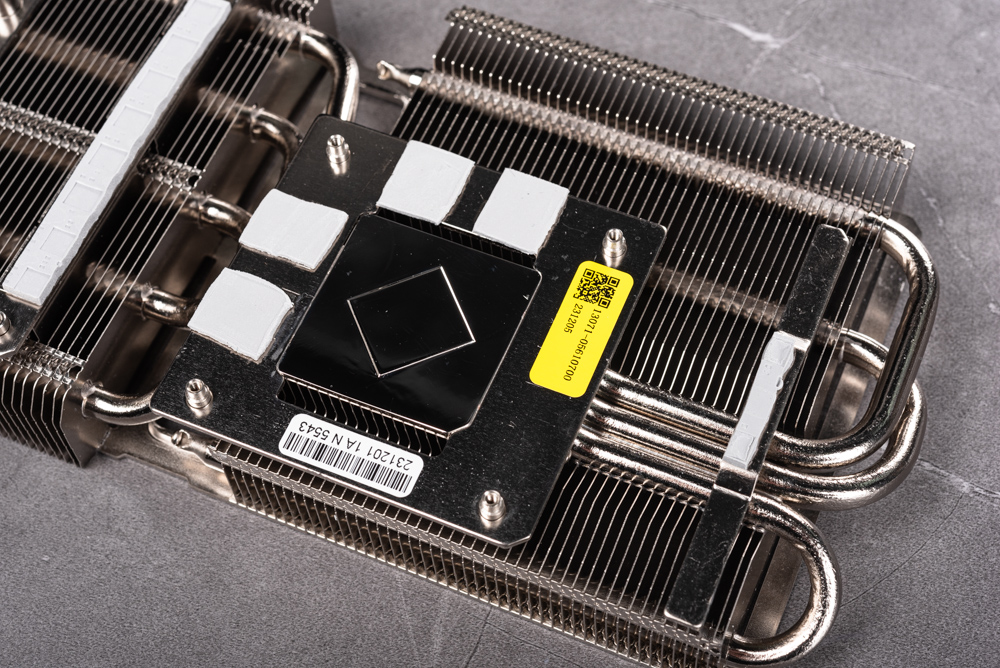
A detailed look at the heatsink of the ASUS TUF Gaming RX 7600 XT OC 16GB graphics card, highlighting the craftsmanship and design engineered for optimal thermal management.
The key features observed include:
- Nickel-Plated Copper Base: The central part of the heatsink that makes contact with the GPU is nickel-plated copper, which is excellent for thermal conductivity. The shiny, reflective surface suggests a smooth finish for efficient heat transfer from the GPU to the heatsink.
- Memory and VRM Cooling: Surrounding the central copper base are thermal pads that interface with the memory modules and voltage regulation modules (VRMs) to dissipate heat away from these components as well, which is critical for maintaining overall system stability.
- Heat Pipes: The heatsink employs three U-shaped heat pipes, contributing to a total of five that run through the heatsink. These heat pipes are designed to quickly transfer heat away from the copper base and distribute it along the heatsink fins.
- Heatsink Fins: The aluminum fins are densely packed to increase the surface area for heat dissipation. Their arrangement allows for air to flow through and carry the heat away from the fins, aided by the axial fans when the card is fully assembled.
- Craftsmanship: The overall construction of the heatsink shows a high level of craftsmanship with precision in the arrangement and soldering of the heat pipes and fins, ensuring the best possible thermal performance.
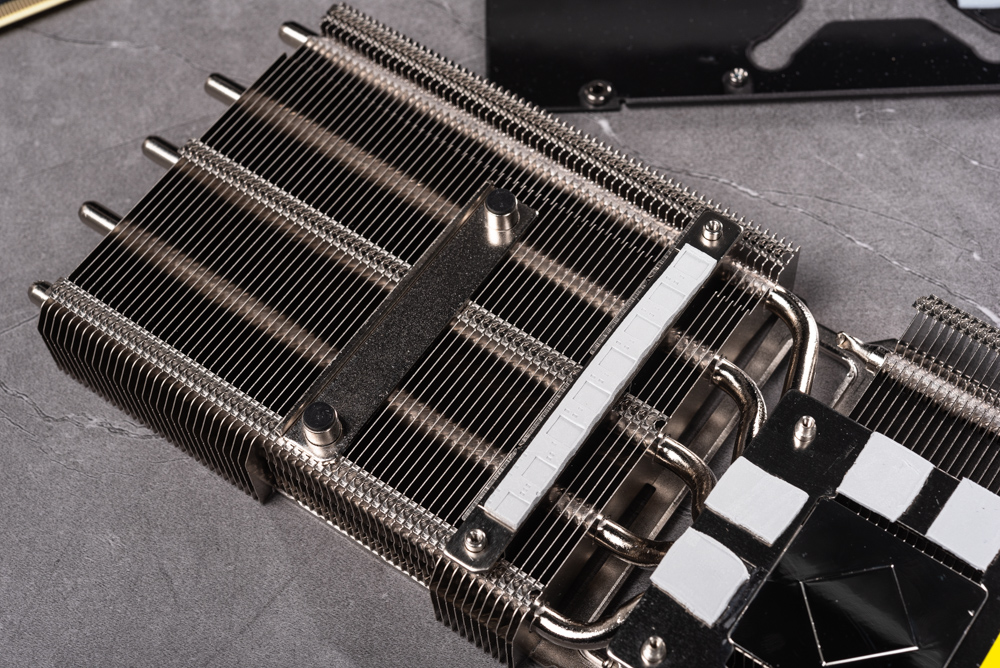
This heatsink design is indicative of ASUS’s TUF series, which is known for robust and reliable cooling solutions. Such efficient thermal management is key to achieving high performance without thermal throttling, ensuring the graphics card can run at peak performance for extended periods. The attention to detail in the design and manufacture of the cooling system reflects the brand’s commitment to quality and performance.
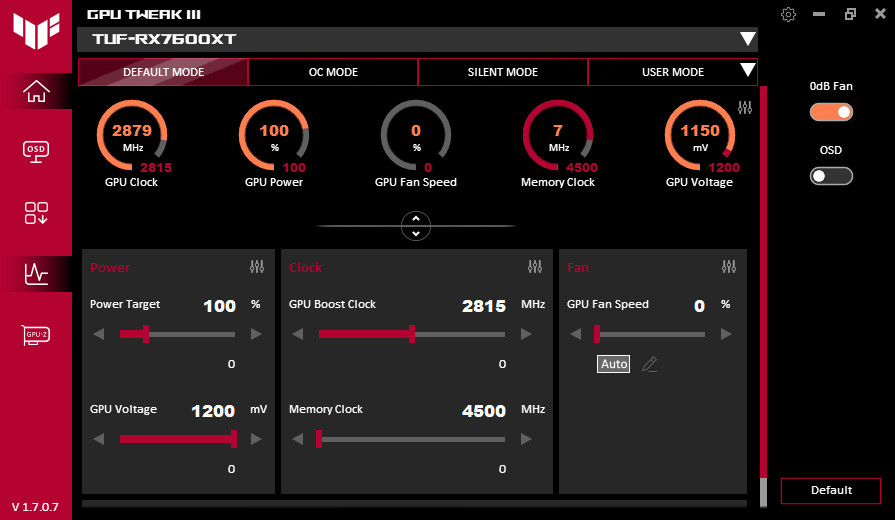
The GPU Tweak III software interface is a utility provided by ASUS for their TUF Gaming RX 7600 XT OC 16GB graphics card. This software offers a comprehensive set of tools for customizing and monitoring the card’s performance.
Here’s a breakdown of the features and functionalities visible in the interface:
- Operating Modes: The software includes preset profiles such as Default Mode, OC (Overclocking) Mode, and Silent Mode, allowing users to switch between different performance settings depending on their needs.
- Overclocking Tools: Users have the ability to manually adjust the GPU’s clock speeds, with the GPU Boost Clock slider set at 2815 MHz in this instance, and the Memory Clock set at 4500 MHz. The GPU Voltage has been adjusted to 1200 mV, indicating an increase from the default setting to accommodate the overclock.
- Fan Control: The GPU Fan Speed can be manually adjusted or set to Auto, which will manage the fan speeds based on temperature thresholds. The 0dB Fan feature likely refers to a passive cooling mode where the fans will stop under low-load conditions to reduce noise.
- Power Target: This slider allows users to set the power limit for the GPU, which can affect performance and thermal characteristics. In the screenshot, it’s set to 100%, which is typically the default setting.
- Monitoring and On-Screen Display (OSD): The software also includes monitoring tools that track various aspects of the card’s performance in real-time and an OSD feature that can display this information during gameplay or other full-screen applications.
- Version Information: The software version is 1.7.0.7, which may be useful for users seeking updates or troubleshooting.
Overall, GPU Tweak III is designed to give users granular control over their graphics card’s performance parameters, from simple mode switching to advanced tuning for overclocking enthusiasts. It enhances the user experience by allowing one to tailor the card’s operation to specific requirements, whether it’s achieving maximum performance for gaming or optimizing for quiet operation during light use.
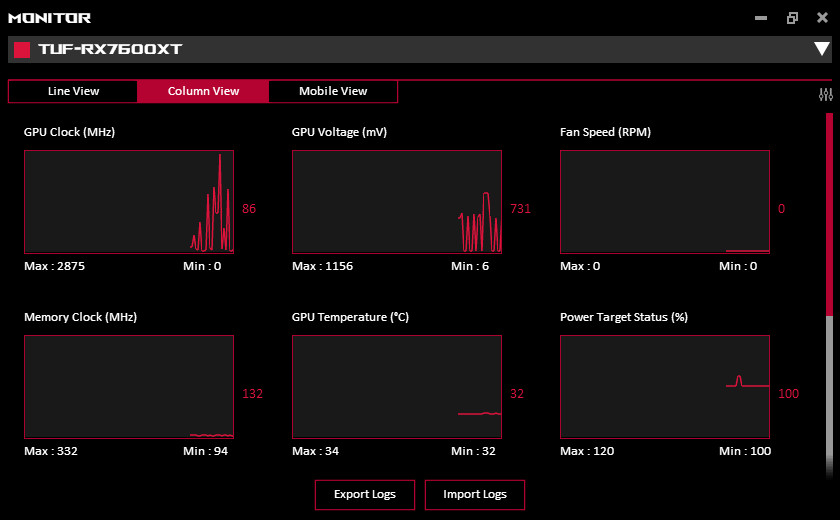
The monitoring tab of the ASUS GPU Tweak III software for the TUF-RX7600XT graphics card. This interface displays real-time data on the card’s performance metrics, allowing users to track how the card is operating under various conditions. Here’s a breakdown of the monitoring features shown:
- GPU Clock (MHz): It shows the real-time clock speed of the GPU. The graph indicates fluctuations in the GPU clock speed with a maximum value recorded at 2875 MHz.
- GPU Voltage (mV): This graph tracks the voltage being supplied to the GPU, with a peak value at 1156 millivolts, suggesting voltage changes, possibly due to varying load or overclocking.
- Fan Speed (RPM): Currently, it indicates that the fans are not spinning, which could be due to the 0dB Fan feature where fans stop under low-load conditions to reduce noise.
- Memory Clock (MHz): Displays the memory clock speed, peaking at 332 MHz. This may reflect idle or low-load conditions or could be an artifact of how the monitoring software reads memory clock speeds under certain conditions.
- GPU Temperature (°C): It indicates the temperature of the GPU, which is a critical metric for understanding the effectiveness of the cooling solution. The GPU is running at a temperature between 32°C and 34°C, which is quite cool and suggests either an idle state or very light use.
- Power Target Status (%): Reflects the power limit relative to the card’s maximum design power, with a maximum of 120% and a minimum of 100%, which can influence performance and heat output.
The software also includes options to export or import logs, which can be used for detailed analysis or troubleshooting. Monitoring these parameters is key for enthusiasts who want to ensure they are getting the best performance without pushing their hardware beyond safe operational limits. The GPU Tweak III software provides an essential interface for enthusiasts to engage with their hardware at a detailed level.
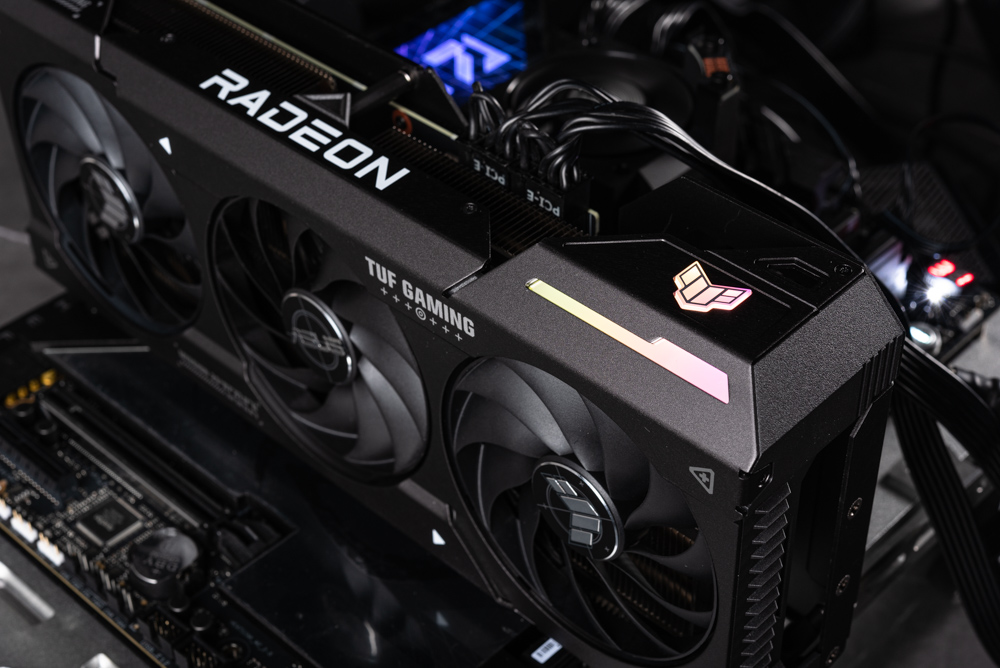
The ASUS TUF Gaming RX 7600 XT OC 16GB graphics card is installed in a computer system, with the RGB lighting effects activated. The TUF Gaming logo is illuminated along with a stylized strip of light on the side of the card, adding to the visual appeal and enhancing the overall aesthetic of the gaming setup.
RGB lighting on graphics cards is a popular feature among gamers and PC enthusiasts who enjoy customizing their rigs to reflect their personal style or match their gaming environment. These lights can often be controlled and customized via software, allowing users to select different colors, effects, and synchronization with other RGB components within their system.
This particular model appears to be designed with a subtle and sleek lighting effect, which complements the card’s overall design and the branding of the TUF Gaming series, known for its balance of performance and durability. The lighting feature adds an extra layer of customization for users looking to build a PC that looks as good as it performs.
ASUS TUF Gaming RX 7600 XT OC 16GB Performance Review: 1440p and 1080p Gaming Benchmarks Unveiled
For the gaming performance test, the setup will utilize resolutions of 1440p and 1080p with all visual effects set to maximum. The tests will include a range of game types, such as competitive esports titles, AAA games, and ray tracing-enabled games. The performance will be evaluated under various conditions:
- Baseline Performance: This is the GPU’s raw performance without any ray tracing (RT) or FidelityFX Super Resolution (FSR) acceleration enabled. It provides a point of reference for the card’s capabilities without any performance-enhancing features.
- Performance with Ray Tracing and FSR: The tests will also measure how the GPU performs when these features are enabled, which can significantly affect frame rates and visual fidelity. Ray tracing adds realistic lighting effects, while FSR aims to improve frame rates through upscaling technologies.
- Performance with AMD Fluid Motion Frames (AFMF): This feature will be tested separately to see its impact on performance. AFMF is designed to deliver smoother motion in games, particularly at lower frame rates, by interpolating additional frames.
The test platform is a high-end configuration, ensuring that the CPU or other components don’t bottleneck the GPU’s performance:
- CPU: Intel Core i9-14900K, a top-tier processor capable of handling intense computing tasks.
- Motherboard: ASUS ROG MAXIMUS Z790 DARK HERO, known for its robust power delivery and overclocking capabilities.
- Memory: Crucial Pro DDR5 5600 32GBx2, providing ample and fast memory for gaming and multitasking.
- Graphics Cards: TUF Gaming RX 7600 XT OC and RX 7600, which will be compared to see the performance difference between the overclocked and non-overclocked versions.
- System Drive: Solidigm P44 Pro 1TB PCIe 4.0 SSD, ensuring fast load times and data transfer.
- Cooler: ASUS ROG RYUJIN III 360, a high-performance liquid cooler to maintain optimal CPU temperatures.
- Power Supply: Seasonic FOCUS GX (ATX3.0) 750W, providing reliable power to support the system’s components.
- Operating System: Windows 11 Pro 21H2 64bit with Resizable BAR On, which can affect GPU performance by allowing full access to the GPU memory.
- Driver Version: AMD 23.40.01.15, the specific driver version is crucial for performance comparison and troubleshooting.
This setup aims to push the graphics cards to their limits and provide detailed insights into their performance across different scenarios and settings. Such testing is invaluable for potential buyers and enthusiasts looking to understand how the card will perform in real-world gaming conditions.
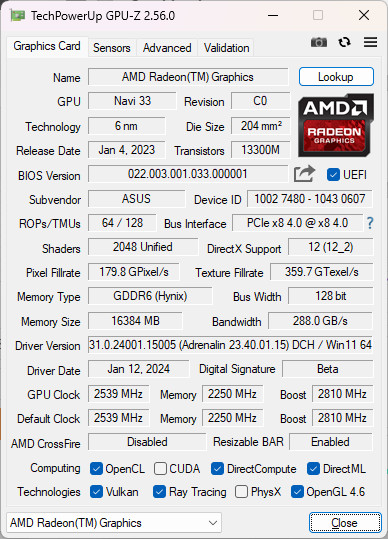
The TechPowerUp GPU-Z utility provides detailed specifications of the AMD Radeon RX 7600 XT graphics card:
- GPU Name: AMD Radeon(TM) Graphics with the Navi 33 GPU core, built on a 6nm process technology.
- GPU Clocks: The card features a base clock of 2539 MHz with a boost clock up to 2810 MHz.
- Stream Processors: It is equipped with 2048 rendering cores.
- Memory: The card has 16384 MB (16 GB) of GDDR6 memory supplied by Hynix.
- Memory Bus and Bandwidth: The memory operates on a 128-bit bus with a bandwidth of 288.0 GB/s.
- Additional Details: It supports DirectX 12 and PCIe 4.0 x8 interface. The card has 64 ROPs/TMUs and comes with features like Resizable BAR enabled, which can improve performance in certain scenarios by allowing full access to the graphics card’s memory.
The listed specifications reflect a powerful mid-range graphics card capable of handling current gaming and rendering tasks efficiently, particularly considering the high boost clock and substantial memory capacity. The presence of GDDR6 memory suggests a good balance between cost and performance, as this type of memory provides high bandwidth suitable for gaming at high resolutions and detail settings.
The software version of GPU-Z shown is 2.56.0, and the driver version is 31.0.12001.10005 (Adrenalin 23.40.01.15-DC). The GPU-Z utility is unable to show complete information for the RX 7600 XT, which could be due to the newness of the card relative to the software’s version. It’s common for GPU information utilities to require updates to fully support the latest hardware releases.
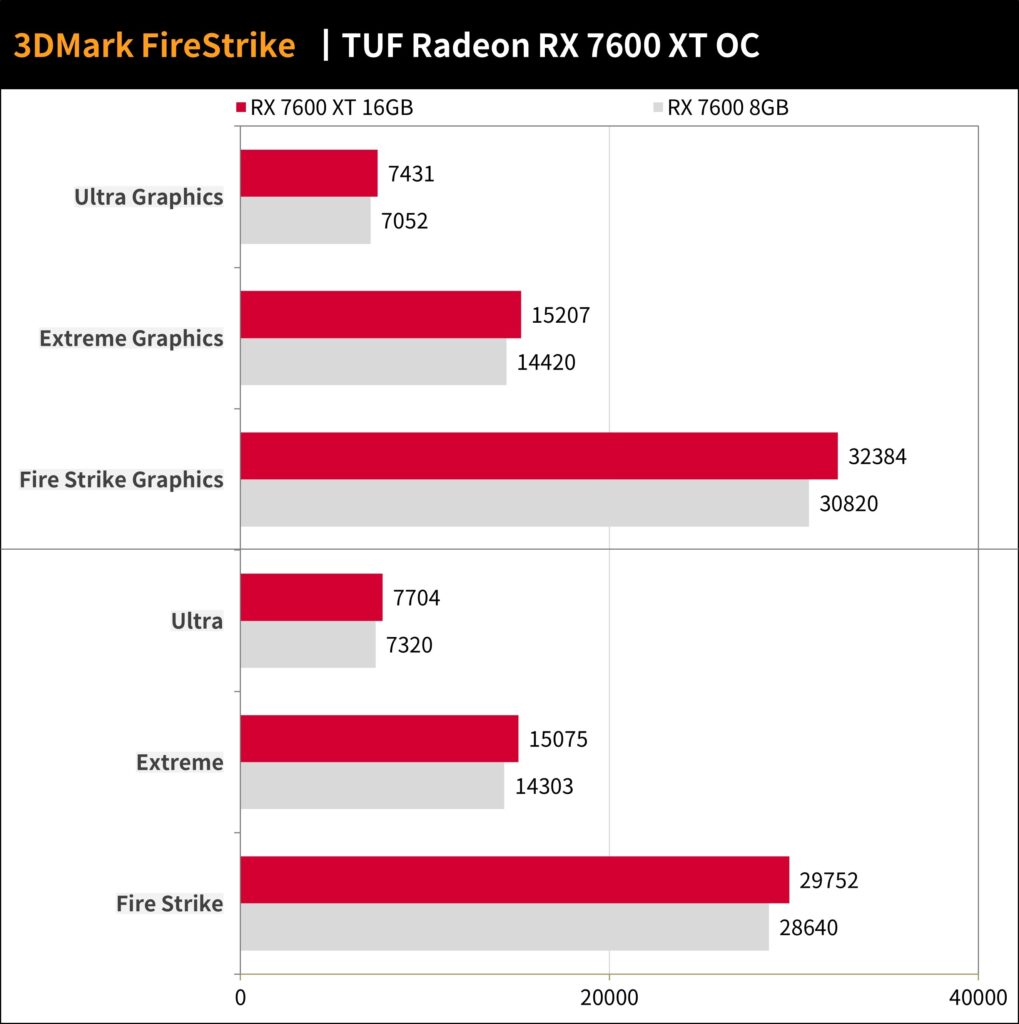
The results of 3DMark Fire Strike benchmarks, a popular synthetic benchmarking tool for GPUs that evaluates their performance using the DirectX 11 API. The tests are conducted at different resolutions and detail levels, assessing how well the graphics card can handle gaming at 1080p (Fire Strike Graphics), 1440p (Fire Strike Extreme Graphics), and 2160p (Fire Strike Ultra Graphics).
Here are the results for the TUF Radeon RX 7600 XT OC:
- Fire Strike (1080p): The RX 7600 XT scores 32,384 points, indicating strong performance at this resolution.
- Fire Strike Extreme (1440p): The card achieves 15,207 points, showing its capability to handle more pixels and more demanding graphics workloads.
- Fire Strike Ultra (2160p): The score is 7,431 points, which suggests that the card is capable of running games at 4K with reasonable performance, although this is the most taxing of the three tests and typically results in lower scores.
In comparison, the RX 7600 (without XT), which presumably has a lower clock speed and possibly less memory (8GB as opposed to the XT’s 16GB), scores lower in each of the tests. The average performance increase for the RX 7600 XT over the RX 7600 is about 5% across these tests.
This increase in performance can be attributed to the higher clock speeds, more memory, and potentially better thermal and power delivery systems on the XT variant. These results are useful for potential buyers comparing the TUF Gaming RX 7600 XT OC against its non-XT counterpart, as they provide a quantifiable measure of the increased performance one can expect from the overclocked and more robustly specced model.
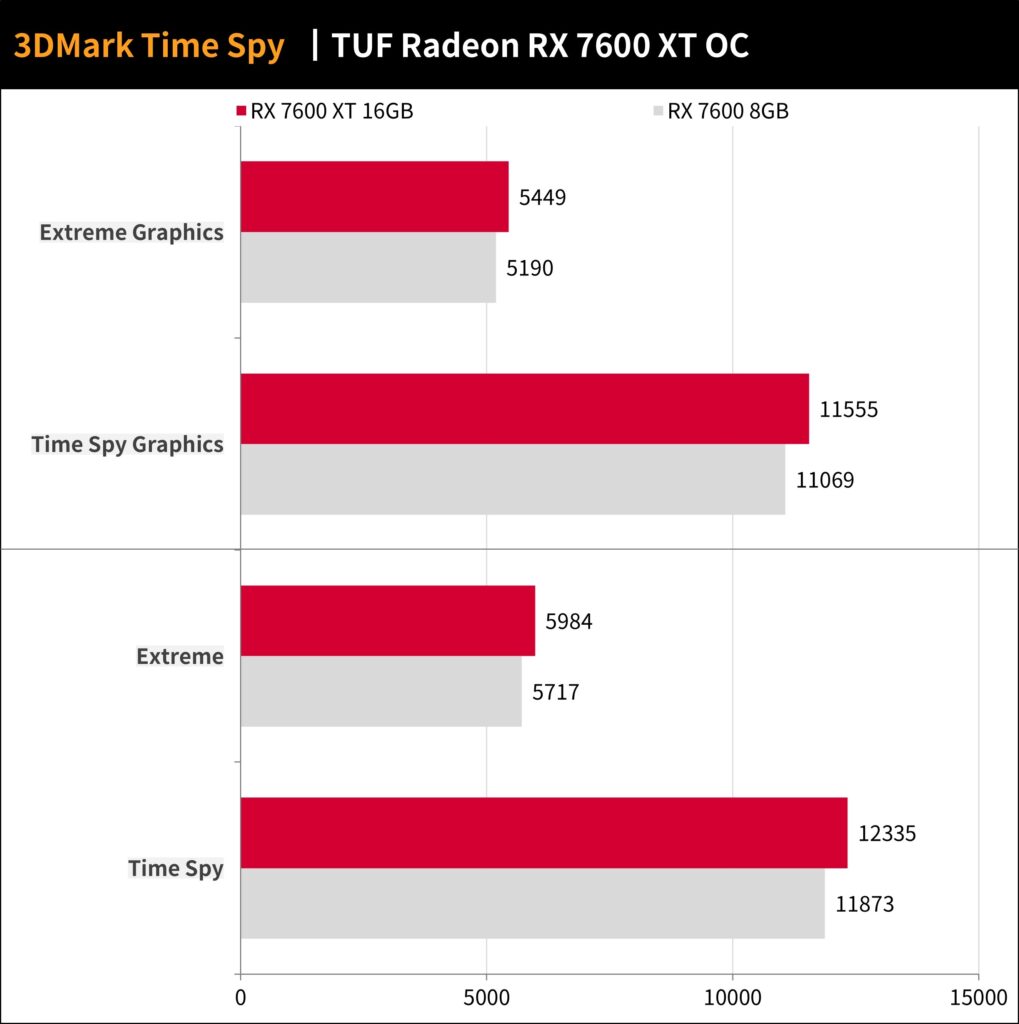
The benchmark results from 3DMark Time Spy, which is designed to assess graphics performance using the DirectX 12 API, a more modern and demanding graphics API than DirectX 11 used in Fire Strike. Time Spy is focused on AAA gaming performance at resolutions of 1440p for the standard test and 2160p (4K) for the Extreme version.
The benchmark results are as follows:
- Time Spy (1440p): The TUF Radeon RX 7600 XT OC scores 11,555 points.
- Time Spy Extreme (2160p): In the more demanding 4K test, the card achieves 5,449 points.
These scores reflect a performance increase of approximately 5% for the RX 7600 XT compared to the RX 7600. This increase is consistent with the expected improvement due to the higher clock speeds and possibly greater memory bandwidth of the XT variant over the non-XT.
The consistent performance uplift of 5% in both Fire Strike and Time Spy suggests that the RX 7600 XT OC delivers a stable and predictable performance advantage across different gaming scenarios and resolutions. These benchmarks are valuable for users to understand the expected performance level of the card, particularly in DirectX 12 titles, which are becoming the standard for modern PC gaming.
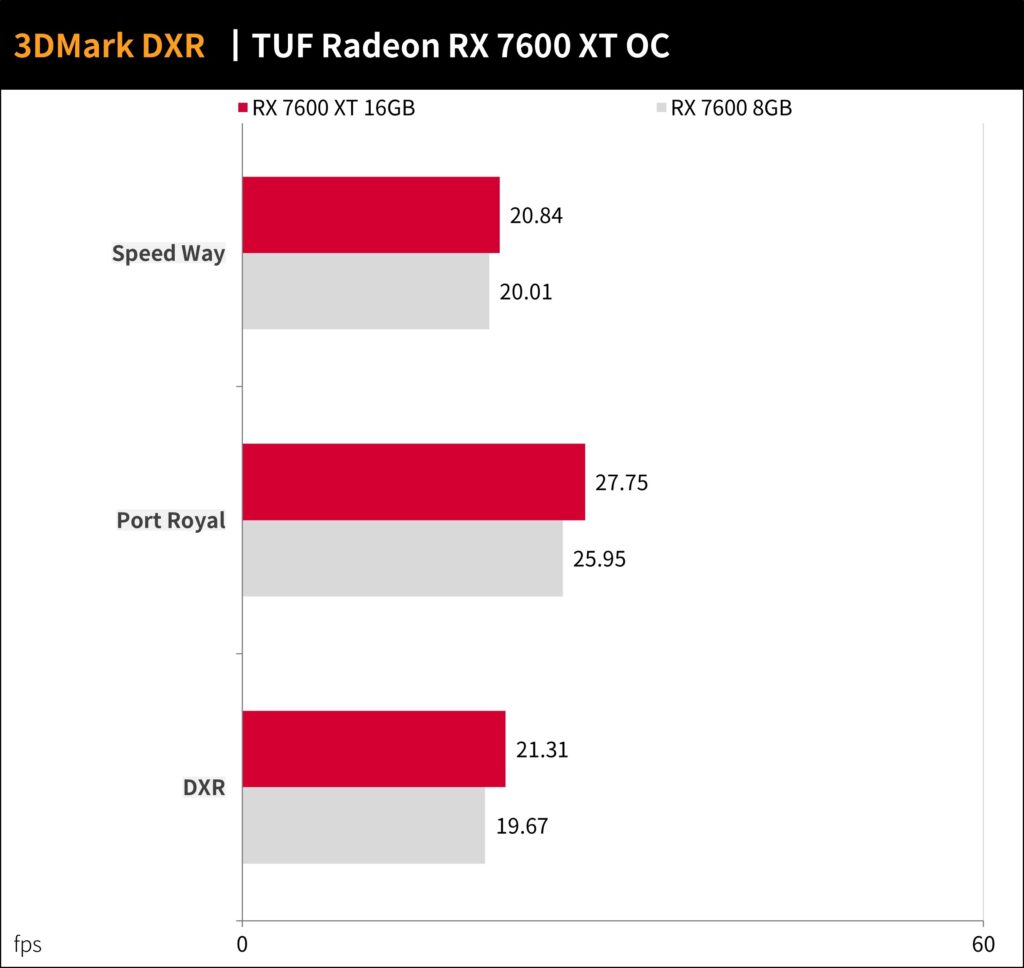
The results from 3DMark ray tracing benchmarks are designed to evaluate a GPU’s performance with real-time ray tracing enabled. These tests provide insight into how well the GPU can handle the computationally intensive task of ray tracing, which significantly impacts rendering and gaming performance. The specific benchmarks include:
- Port Royal: A scenario designed to test the ray tracing performance in AAA gaming contexts.
- DXR: A test that uses the DirectX Raytracing (DXR) API for feature testing.
- Speed Way: A test scenario developed using full path tracing (a form of ray tracing).
The TUF Radeon RX 7600 XT OC has the following results:
- Port Royal: The card achieves 27.75 FPS, indicating its ability to run ray tracing in complex scenes at a playable frame rate.
- DXR: It scores 21.31 FPS, demonstrating the raw ray tracing capabilities of the hardware.
- Speed Way: The card reaches 20.84 FPS, showcasing its performance in a fully path-traced environment.
Compared to the RX 7600 8GB, the RX 7600 XT 16GB shows a performance increase of approximately 6%. While the term “悽慘” (pitiful) may suggest that the performance is not meeting high expectations, it is important to note that ray tracing is extremely demanding. A 6% increase in such demanding tests is quite significant and shows that the RX 7600 XT has tangible improvements over its non-XT counterpart in handling ray tracing tasks.
This data is useful for consumers who are interested in the ray tracing performance of their GPUs, as it indicates how well the RX 7600 XT can handle one of the most advanced graphics technologies available in gaming today.
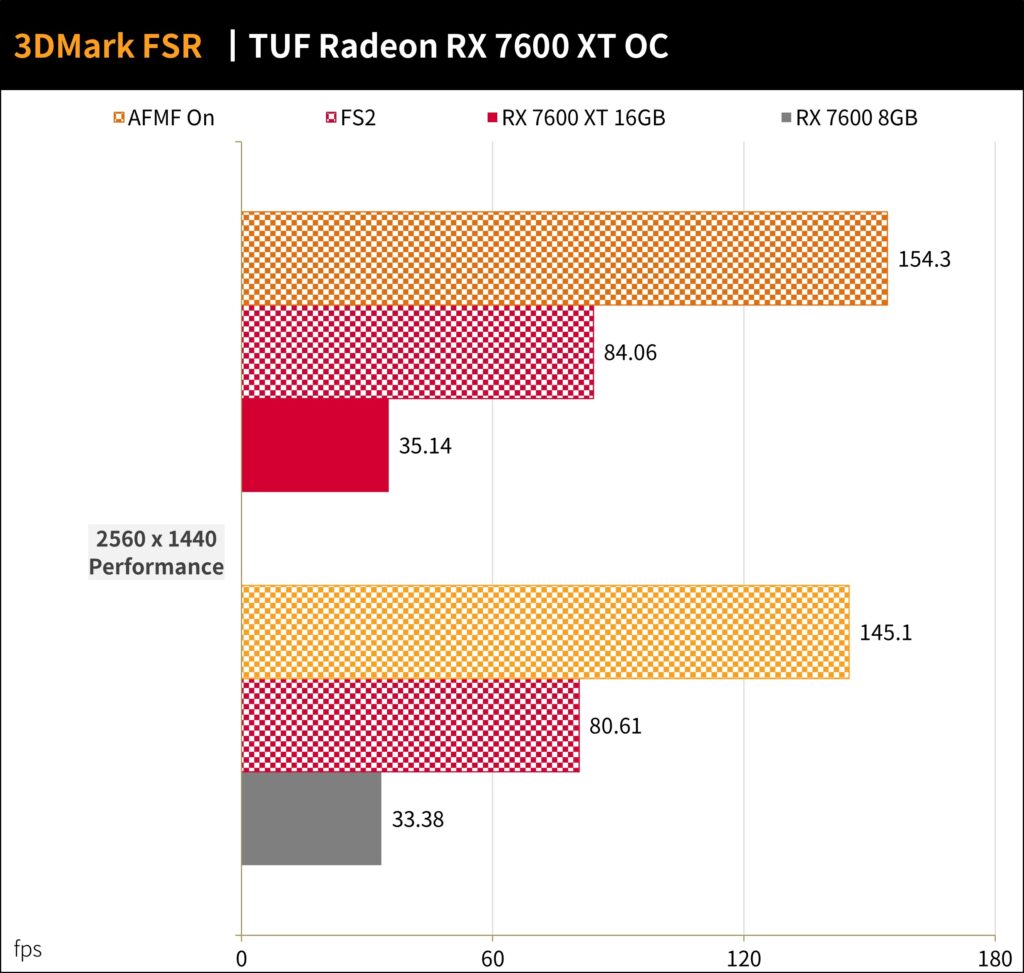
The results of 3DMark’s FSR (FidelityFX Super Resolution) test for the TUF Radeon RX 7600 XT OC graphics card. This test measures the performance improvement offered by FSR, AMD’s upscaling technology designed to boost frame rates without significantly sacrificing image quality. The benchmark compares the performance at a resolution of 2560 x 1440 (1440p) under different settings:
- Baseline Performance (No FSR): The RX 7600 XT manages 35.14 FPS at native 1440p resolution, representing the card’s performance without any upscaling or performance enhancement features.
- Performance with FSR 2 Enabled: With FSR 2 Performance mode turned on, the frame rate jumps to 84.06 FPS, which is roughly a 2.39x increase. FSR works by rendering the game at a lower resolution and then using a spatial upscaling algorithm to enhance the image to the target resolution, improving performance.
- Performance with AMD Fluid Motion Frames (AFMF) On: When AFMF is activated via the Radeon Software, the frame rate soars to 154.3 FPS, approximately a 4.3x improvement over the baseline. AFMF is a feature that creates intermediate frames to make gameplay appear smoother, effectively increasing the perceived frame rate.
These results are particularly significant for gamers who wish to play at high resolutions but do not have the hardware capable of maintaining high frame rates at those resolutions. Technologies like FSR and AFMF make it possible to achieve a better balance between image quality and performance, particularly on mid-range cards like the RX 7600 XT. The 6% performance improvement over the RX 7600 8GB model also indicates that the extra memory and possibly other enhancements in the XT model contribute to better handling of demanding resolution and upscaling technologies.
ASUS TUF Gaming RX 7600 XT OC 16GB Esports Performance: Dominating FPS in Top Titles at 1440p and 1080p
The outlines performance benchmarks for the TUF Radeon RX 7600 XT OC in four competitive esports titles at both 1440p and 1080p resolutions with maximum graphics settings. These games—Rainbow Six Siege, League of Legends, Apex Legends, and Counter-Strike 2—are known for requiring high frame rates to ensure smooth gameplay that complements fast-paced, skill-based actions.
Here are the performance details at 1440p resolution:
- Counter-Strike 2: The RX 7600 XT averages 116 FPS, which is a 7% improvement over the RX 7600.
- Apex Legends: The card achieves an average of 154 FPS.
- Rainbow Six Siege: The card performs at an average of 277 FPS, showing a 5% increase from the RX 7600.
- League of Legends: The card excels with a very high average of 554 FPS.
At 1080p resolution, the RX 7600 XT still provides ample performance and shows an approximate 2% improvement over the RX 7600. These results suggest that the RX 7600 XT OC is well-suited for competitive gaming, delivering the high frame rates necessary for a fluid and responsive experience.
The slight performance gains over the RX 7600 indicate that the XT variant, with its overclocked settings and possibly more robust cooling solutions, can provide a competitive edge in scenarios where every frame can make a difference. This data can help gamers make informed decisions when considering which GPU best fits their needs for competitive gaming, especially when looking for hardware that can deliver high performance at higher resolutions like 1440p.
ASUS TUF Gaming RX 7600 XT OC 16GB AAA Gaming Test: High FPS Achieved in Top Titles at 1440p and 1080p
Referring to performance benchmarks for the TUF Radeon RX 7600 XT OC graphics card across a selection of AAA titles at 1440p and 1080p resolutions with maximum graphics settings. The benchmarks focus on traditional rendering performance in games without the use of ray tracing (except for “F1® 22”) or FidelityFX Super Resolution (FSR) technologies.
Here’s a summary of the performance:
- At 1440p resolution:
- The RX 7600 XT achieves an average of 80 FPS across the AAA titles tested.
- Compared to the RX 7600, there’s an approximate performance increase of 4%.
- At 1080p resolution:
- The RX 7600 XT reaches an average of 116.4 FPS.
- This represents a 6% performance boost over the RX 7600.
The games used in the test include newly released titles such as “Diablo IV” and “Avatar: Frontiers of Pandora,” as well as other graphically demanding games like “F1® 22,” “Shadow of the Tomb Raider,” “Horizon Zero Dawn,” “Borderlands 3,” “Assassin’s Creed Valhalla,” “Red Dead Redemption 2,” and “God of War.”
The reported performance improvement at both resolutions indicates that the RX 7600 XT OC is capable of handling current AAA gaming demands with good frame rates, particularly at the more common gaming resolution of 1080p. The modest improvement over the RX 7600 suggests that the XT version, with its overclocked specs, can deliver better performance, which can be particularly important for gamers looking for smooth gameplay in visually complex and demanding game environments.
ASUS TUF Gaming RX 7600 XT OC 16GB Ray Tracing Test: Boosted Performance in Top DXR Titles at 1440p and 1080p
The performance of the TUF Radeon RX 7600 XT OC in a series of DirectX Raytracing (DXR) enabled games, tested at both 1440p and 1080p resolutions with maximum graphics and ray tracing settings, along with FidelityFX Super Resolution (FSR) acceleration enabled to improve frame rates.
Here’s an overview of the gaming performance:
- At 1440p resolution with FSR enabled:
- “Far Cry 6” averages 93 FPS.
- “Marvel’s Guardians of the Galaxy” averages 68 FPS.
- “Spider-Man: Miles Morales” averages 57 FPS.
- “Cyberpunk 2077” averages 42.4 FPS.
- The average FPS across the seven ray tracing games is 50.9 FPS.
- Performance Improvement:
- At 1440p, the RX 7600 XT shows a 28% average performance increase in ray tracing games over the RX 7600.
- However, despite the significant performance boost, demanding ray tracing titles, even with FSR 2 acceleration, may still struggle to run smoothly.
- At 1080p resolution:
- The RX 7600 XT’s average increases to 67.9 FPS.
- “Cyberpunk 2077” reaches an average performance of 62.38 FPS.
- Compared to the RX 7600, there’s a performance increase of about 15%.
- Some poorly optimized ray tracing games still present challenges in terms of performance.
The substantial performance gains at 1080p resolution suggest that the RX 7600 XT OC is more suited for gamers who prioritize high frame rates with ray tracing effects enabled and are willing to play at this lower resolution. The increase in performance with FSR indicates that AMD’s upscaling technology effectively boosts frame rates, which is critical for playability in ray-tracing titles. Despite this, the mention of “some poorly optimized ray tracing games” suggests that there are still titles where the demands of ray tracing can overwhelm even the improved capabilities of the RX 7600 XT OC. This is valuable information for gamers considering this GPU and looking to play the latest ray-traced games.
ASUS TUF Gaming RX 7600 XT OC 16GB Power and Temperature Analysis: Efficiency Meets Performance
The TUF Gaming RX 7600 XT OC 16GB graphics card provides important insights into its efficiency and thermal performance under load.
Temperature Performance:
- During the Speed Way Stress test, the TUF Gaming RX 7600 XT OC 16GB achieves an impressively low maximum temperature of only 55°C.
- While playing “Cyberpunk 2077,” the temperature remains comparably low at 54°C.
- These temperatures are significantly lower than those recorded for the standard RX 7600, indicating that the TUF Gaming version has superior cooling capabilities.
Power Consumption (TBP – Typical Board Power):
- The TUF Gaming RX 7600 XT OC 16GB shows an average power consumption of 193W during the Speed Way Stress test.
- The Furmark 4K Xtreme burn-in test pushes the card to a maximum power draw of 192.1W.
- During gameplay with “Cyberpunk 2077,” the card’s power consumption is slightly lower at 187.8W.
The power consumption figures suggest that the TUF Gaming RX 7600 XT OC 16GB has a well-managed power draw considering its performance, with the card’s power requirements staying under the 200W mark even during intensive tasks. The cooling system of the card also seems to be highly efficient, keeping temperatures remarkably low during both synthetic benchmarks and actual gameplay, which is essential for maintaining the longevity and performance of the GPU.
These results would be appealing to gamers and PC enthusiasts who are looking for a powerful yet efficient graphics card for gaming and other demanding applications. The data indicates that ASUS has optimized the TUF Gaming RX 7600 XT OC not only for performance but also for maintaining operational efficiency and thermal control.
Exploring AMD FidelityFX Super Resolution 3: Boosting Game Performance with AFMF Technology
The workflow of AMD FidelityFX Super Resolution 3 (FSR 3), which is an advanced upscaling technology that aims to improve gaming performance by increasing frames per second (FPS) without significantly impacting visual quality.
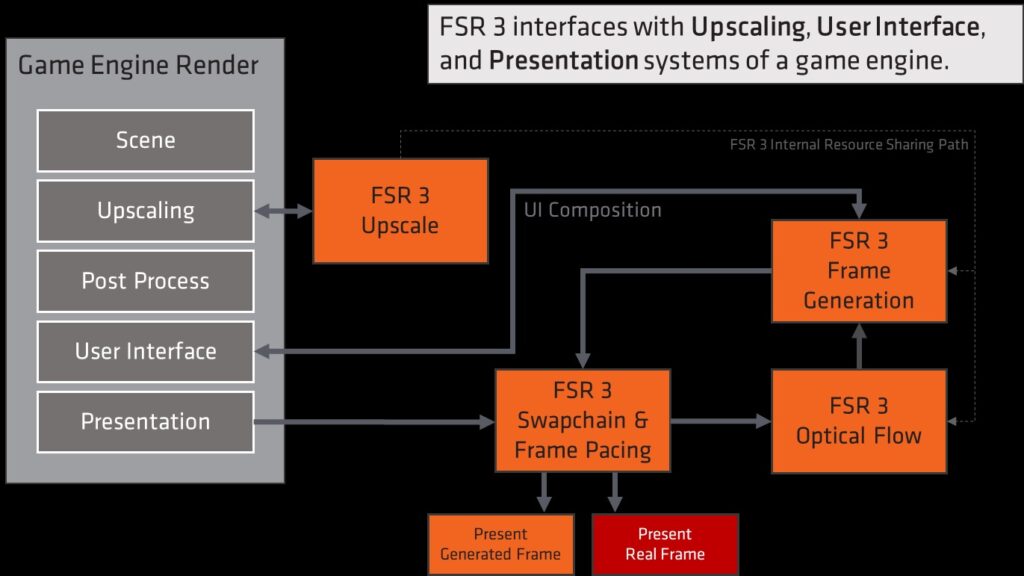
Here’s an explanation of the FSR 3 workflow components as described in the diagram:
- FSR 3 Upscale: This step is where the actual resolution upscaling takes place. The game engine renders the scene at a lower resolution, which is then upscaled to the target resolution using the FSR 3 technology, providing a balance between performance and image quality.
- Optical Flow: This component calculates motion vectors for pixels on the screen, which are essential for the next step in the process. Optical flow is a technique used to estimate motion between frames in a sequence, which is crucial for accurate frame interpolation.
- Frame Generation: Using the motion vectors calculated by the optical flow, FSR 3 generates additional frames (frame interpolation). This helps to achieve a smoother visual experience by increasing the frame rate effectively. It works in conjunction with the game’s UI composition to ensure that interface elements remain sharp and clear.
- Swapchain & Frame Pacing: This is the final step in the FSR 3 process, where the generated frames and the real frames are presented to the display. A replacement swapchain is recommended for developers to handle FSR 3 independently and asynchronously, ensuring efficient frame pacing and minimizing input latency.
Overall, FSR 3 integrates with a game engine’s upscaling, user interface, and presentation systems to deliver a higher and more stable frame rate. This technology is particularly beneficial in rendering intensive scenes where maintaining a high FPS count is challenging. By combining frame interpolation with advanced upscaling techniques, FSR 3 promises to deliver a smoother and more immersive gaming experience, particularly for gamers with hardware that might not otherwise cope with demanding settings.
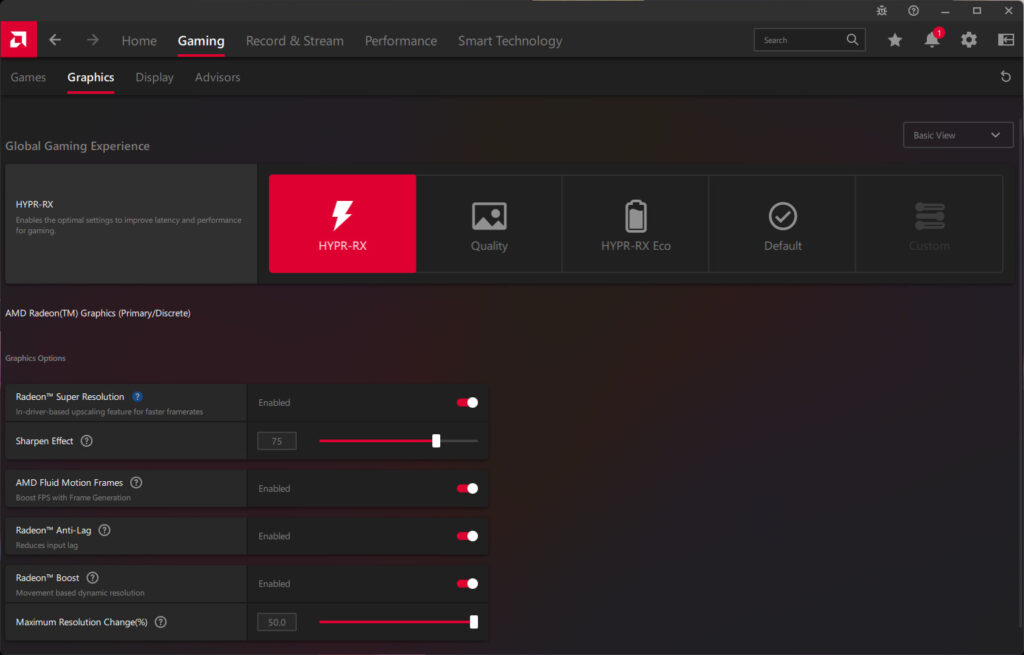
The AMD Radeon Software interface specifically focuses on the ‘Gaming’ and ‘Graphics’ settings. This software allows users to configure various AMD graphics technologies to optimize the gaming experience.
In the screenshot, we can see the “HYPR-RX” setting, which when enabled, optimizes settings to improve latency and performance for gaming. This seems to be a feature that combines multiple AMD technologies to boost gaming performance.
Here’s a breakdown of the features shown:
- Radeon™ Super Resolution (RSR): An in-driver upscaling feature that increases performance by rendering games at a lower resolution and then upscaling them for higher frame rates with minimal loss in image quality.
- Sharpen Effect: This setting allows users to adjust the intensity of the sharpening effect that can be applied to games, enhancing clarity and image detail.
- AMD Fluid Motion Frames: This feature boosts FPS with frame generation, likely referring to the interpolation of frames to create smoother motion in games.
- Radeon™ Anti-Lag: This feature is designed to reduce input latency, making games more responsive.
- Radeon™ Boost: A feature that dynamically adjusts resolution in response to in-game motion to improve performance with minimal impact on visual quality.
- Maximum Resolution Change%: This setting likely controls how much the resolution can be dynamically adjusted when Radeon Boost is enabled.
The “HYPR-RX” setting seems to be an umbrella feature that, when enabled, turns on all the listed Radeon technologies. AMD Fluid Motion Frames has been integrated directly into the Radeon Software, allowing users with compatible RX 5000, RX 6000, and RX 7000 series GPUs to enable it directly from the driver settings. When “HYPR-RX” is turned on, it will also forcibly activate “Anti-Lag” to reduce latency as part of the process.
It is noted that FSR 3 requires game developers and engine support to integrate the technology before players can enable it within the game. Currently, games like “Avatar: Frontiers of Pandora,” “Forspoken,” and “Immortals of Aveum” support it. This integration means that players can enhance their gaming experience directly from the AMD software without waiting for game developers to implement these features.
This software suite appears to be a powerful tool for gamers looking to optimize their systems for better gaming performance, particularly those with the latest AMD GPUs and drivers.
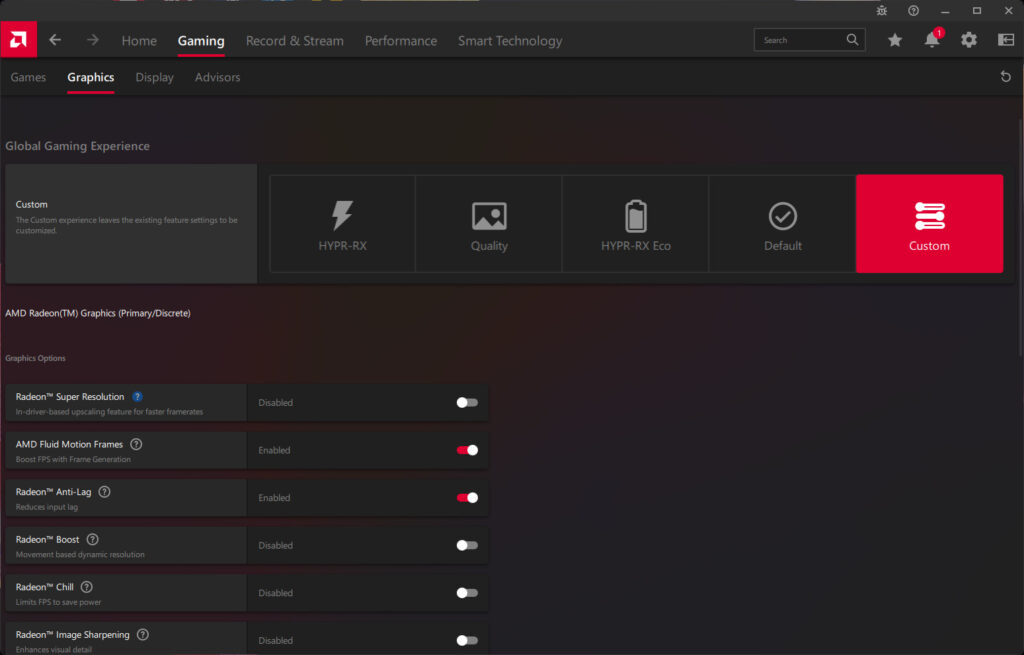
The AMD Radeon Software interface, specifically on the ‘Graphics’ tab within the ‘Gaming’ section. The ‘Custom’ profile appears to be selected, indicating that users can manually adjust the settings as they prefer.
Here’s a brief description of the features available for customization:
- Radeon™ Super Resolution: This feature is currently disabled. When enabled, it provides in-driver upscaling to improve framerates.
- AMD Fluid Motion Frames: This feature is enabled, suggesting that it will be used to boost FPS through frame generation, enhancing smoothness in motion.
- Radeon™ Anti-Lag: Also enabled, this feature aims to reduce input lag, which can improve responsiveness in fast-paced games.
- Radeon™ Boost: This feature is disabled. If enabled, it would dynamically adjust the resolution based on in-game movement to maintain higher frame rates without significantly impacting visual fidelity.
- Radeon™ Chill: This power-saving feature is disabled. When enabled, it limits FPS to reduce power consumption and heat generation.
- Radeon™ Image Sharpening: Currently disabled, this feature enhances visual detail when enabled without a significant impact on performance.
The ‘Custom’ profile allows for granular control over these settings, letting users optimize their gaming experience based on individual preferences or specific requirements of the games they are playing. For example, enabling ‘AMD Fluid Motion Frames’ and ‘Radeon™ Anti-Lag’ while keeping ‘Radeon™ Boost’ and ‘Radeon™ Chill’ disabled might be a choice for gamers who prioritize fluid motion and low latency over power savings and dynamic resolution changes.
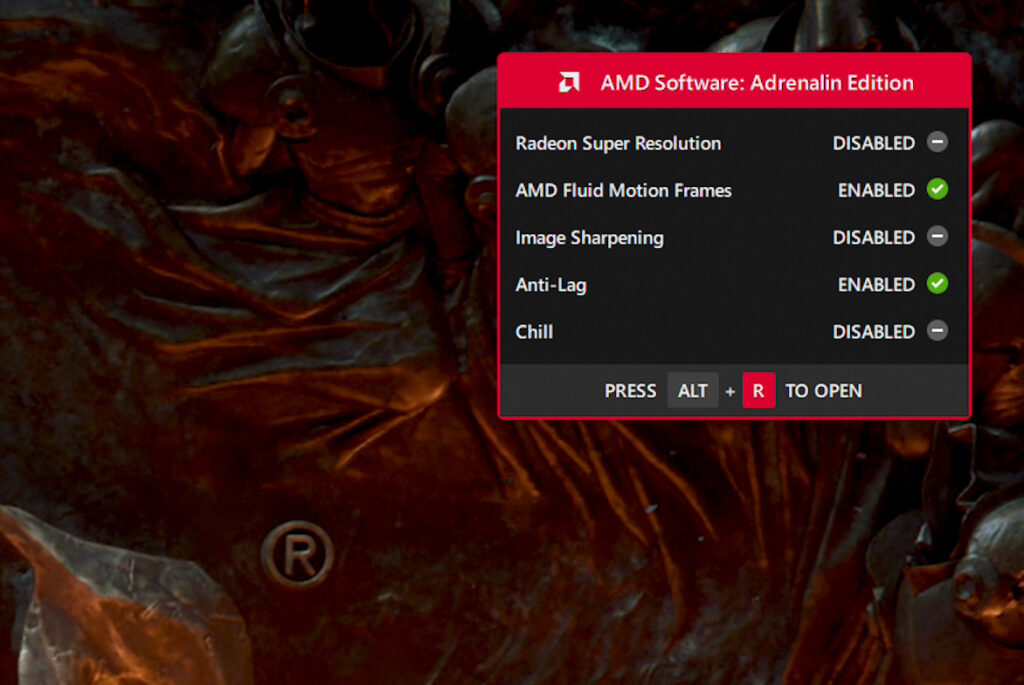
The in-game overlay for AMD Software: Adrenalin Edition, which allows users to quickly check the status of various graphics features and make adjustments on the fly. The overlay is accessible during gameplay, usually by pressing a hotkey combination like “Alt + R.”
Here’s a summary of the features and their status based on the overlay:
- Radeon Super Resolution: Disabled. This is AMD’s in-driver upscaling feature for faster framerates.
- AMD Fluid Motion Frames: Enabled. This feature provides frame rate interpolation to deliver smoother gameplay, enhancing fluid motion regardless of whether the game natively supports FSR 3.
- Image Sharpening: Disabled. When enabled, this feature would enhance the sharpness and clarity of the game visuals.
- Anti-Lag: Enabled. This is designed to reduce input latency, making the gaming experience more responsive.
- Chill: Disabled. This power-saving feature caps the FPS to reduce power consumption and heat generation when active.
The overlay suggests that with AMD Fluid Motion Frames enabled, users can benefit from smoother frame rates even if a game doesn’t natively support FSR 3. However, for the best experience, it is recommended to set the game to ‘Full Screen’ mode and disable ‘Vertical Sync’ (V-Sync). The in-game overlay can be used to confirm whether the Fluid Motion Frames feature is active and working as intended.
This overlay is a handy tool for gamers to optimize their gameplay experience without leaving the game or manually opening the full Radeon Software application. It illustrates AMD’s commitment to providing users with accessible and real-time control over their graphics settings to fine-tune performance and visual fidelity.
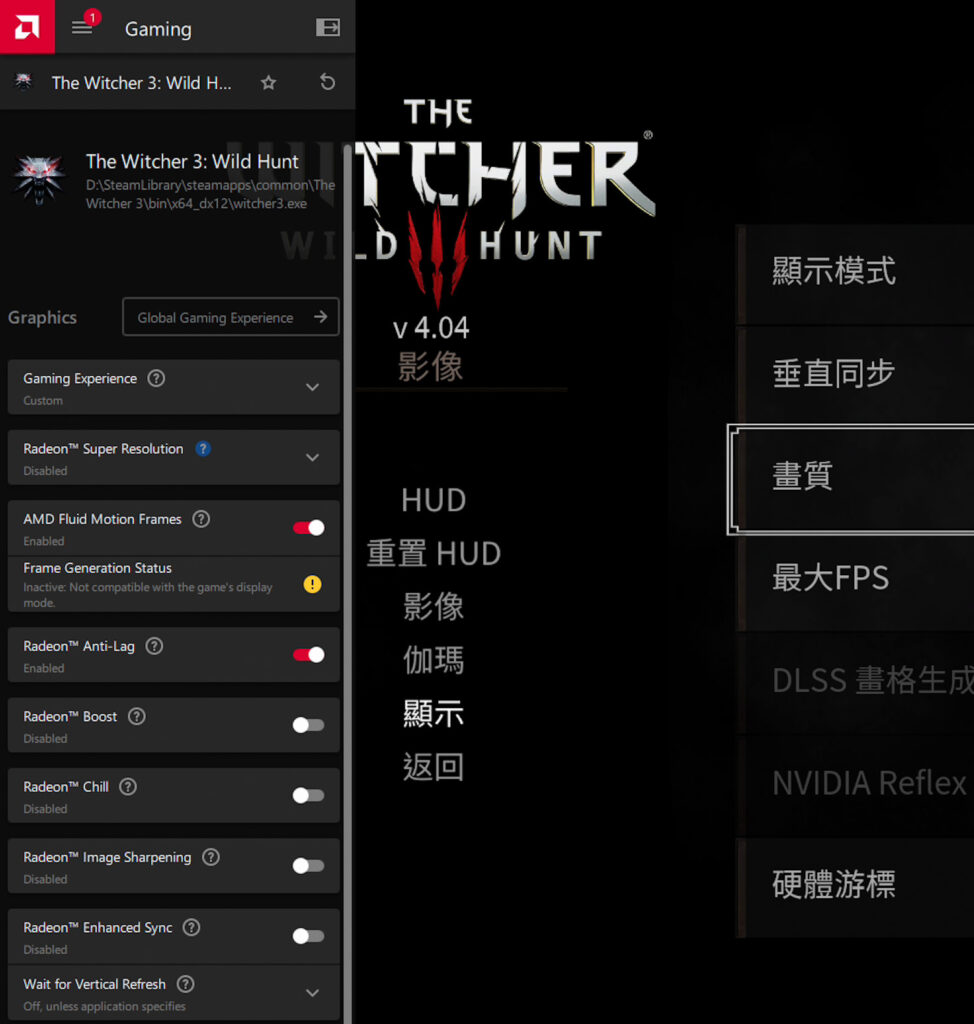
From the AMD Radeon Software settings, specifically showing the configuration for “The Witcher 3: Wild Hunt.” It shows various graphics features and their status, as well as a notification about an activation issue related to AMD Fluid Motion Frames.
Here’s a breakdown of the settings:
- Radeon™ Super Resolution: Disabled. This feature, when enabled, allows for upscaling within the driver to improve framerates.
- AMD Fluid Motion Frames: Enabled. This aims to provide smoother gameplay through frame interpolation.
- Frame Generation Status: Inactive. There’s a warning indicating that the feature is not compatible with the game’s display mode. This could be due to the game running in a mode that doesn’t support this feature (like a windowed or borderless window), or it could be that the feature requires full-screen mode to operate properly.
- Radeon™ Anti-Lag: Enabled. This reduces input latency during gameplay.
- Radeon™ Boost, Radeon™ Chill, Radeon™ Image Sharpening, and Radeon™ Enhanced Sync: All disabled. Each of these features could be enabled depending on user preference or game requirements.
- Wait for Vertical Refresh: Off, unless the application specifies otherwise. This setting relates to V-Sync, which synchronizes the frame rate of the game with the refresh rate of the monitor to reduce screen tearing.
The issue with Frame Generation being inactive might be due to the game’s current display settings or possibly conflicts with other on-screen display (OSD) programs. It’s recommended to check the game’s video settings to ensure it’s running in full-screen mode and that V-Sync is turned off if the user wants to utilize AMD Fluid Motion Frames. Also, closing or disabling any other OSD applications that could interfere with the Radeon Software might resolve the issue.
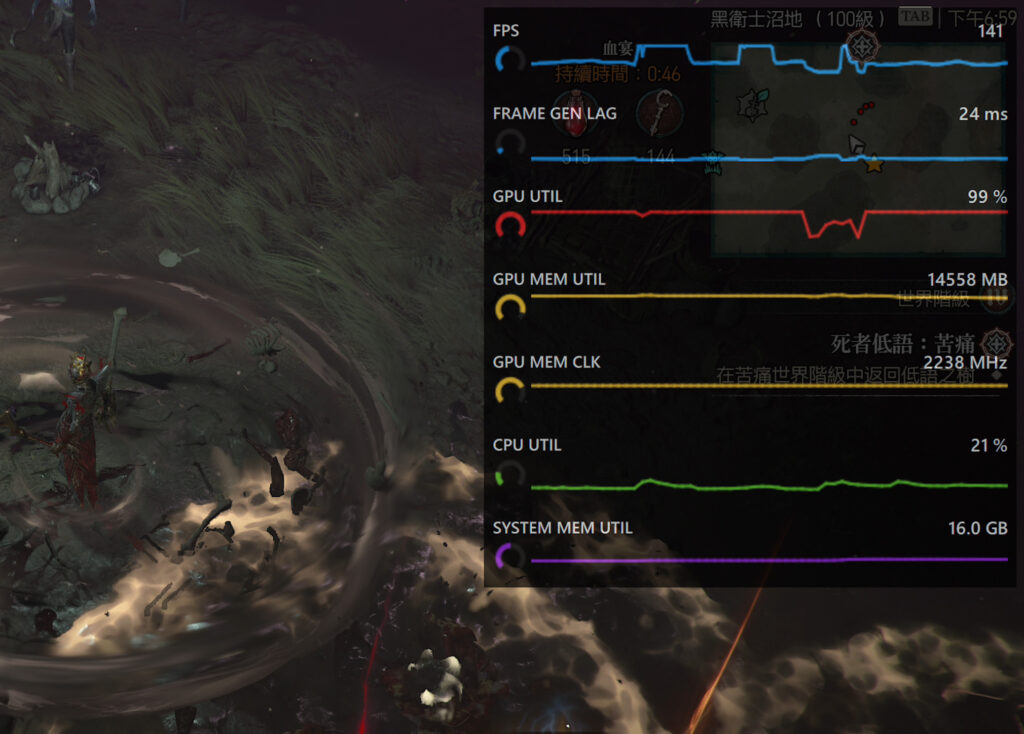
An in-game overlay displaying performance metrics, likely from the AMD Radeon Software’s performance monitoring overlay. It shows various statistics such as frames per second (FPS), frame generation lag, GPU utilization, and memory usage, among others. The presence of “Frame Gen Lag” suggests that AMD’s Fluid Motion Frames feature is active, which can introduce some latency as it works to interpolate frames for smoother performance.
Here’s a brief explanation of the key metrics visible in the overlay:
- FPS: The number of frames being rendered and displayed each second.
- Frame Gen Lag: The latency introduced by frame generation. This is the extra time taken to generate interpolated frames, which can affect responsiveness, especially in fast-paced games.
- GPU UTIL: The percentage of the GPU’s processing capacity being utilized.
- GPU MEM UTIL: The amount of GPU memory (VRAM) being used.
- GPU MEM CLK: The clock speed of the GPU memory.
- CPU UTIL: The percentage of the CPU’s processing capacity being utilized.
- SYSTEM MEM UTIL: The amount of system memory (RAM) being used.
The overlay indicates that the GPU is being heavily utilized (99%), and a substantial amount of GPU memory is in use (14558 MB). The Frame Gen Lag is shown as 24 ms, which is the added latency from the frame generation process. This level of latency may be acceptable for single-player games where the highest level of responsiveness is not critical, but for competitive multiplayer games, lower latency is usually preferred.
The advice to monitor the Frame Gen Lag is important because if it becomes too high, it could negatively impact the gaming experience. Players may need to adjust their settings or disable Fluid Motion Frames for games where low latency is crucial. Using the shortcut Ctrl + Shift + O to toggle the Radeon Software’s OSD is a handy way to keep an eye on these performance metrics during gameplay.
In practical testing, the RX 7600 XT graphics card, when using AMD’s FidelityFX Super Resolution 3 (FSR 3) technology with supported games, shows a significant performance improvement. For instance, in “Avatar: Frontiers of Pandora,” the performance at 1440p resolution reached 116.2 FPS with FSR 3 enabled, almost doubling the FPS compared to when it is not enabled. “Diablo IV” also benefited from the AFMF technology, reaching up to 202 FPS, and “Cyberpunk 2077” averaged a notable 76.9 FPS.
However, for games like “Star Wars Jedi: Survivor” and “The Witcher 3: Wild Hunt,” the performance increase with FSR 3 enabled was marginal. Interestingly, “Hogwarts Legacy” actually saw a decrease in FPS when AFMF was activated, which suggests that AMD Fluid Motion Frames can be enabled via the driver, but the final performance and latency optimization still heavily depends on the game engine’s support and tuning.
The recommendation is that for the mentioned games, including “Star Wars,” “Hogwarts Legacy,” “Cyberpunk 2077,” and “The Witcher 3,” it might be better to disable ray tracing features. This could potentially result in better performance improvements from AFMF technology.
Summarize
After upgrading to 16GB of GDDR6 memory, the AMD Radeon RX 7600 XT averages 80 FPS in AAA games and 50.9 FPS in ray-traced FSR games at 1440p resolution. At 1080p, it averages 116.4 FPS and 67.9 FPS, respectively. Compared to the RX 7600, the RX 7600 XT shows an average performance increase of about 4-6% in AAA games and 15-28% in ray-traced FSR games.
Although there is a relatively high-performance increase in ray-tracing FSR games, the RX 7600 XT still struggles with heavily ray-traced or poorly optimized games. With a US price of $329, the RX 7600 XT’s price in Taiwan may be around the lower end of 10,000 TWD. If players are only interested in 1080p entry-level gaming without ray tracing, the RX 7600 may offer better value for money. However, for 2K gaming, the RX 7600 XT is recommended. Nonetheless, for the latest ray-traced titles, a higher-tier model would be advisable.
Finally, AMD Fluid Motion Frames can be enabled through the driver, but the performance gains are limited without game optimization and may increase latency. Players may need to adjust the resolution and effect settings themselves for the best experience. There is also hope that more games will support FSR 3 frame rate boosting technology in the future.
If this article is helpful for you, please share this article with your friends on social media. Thank you!
This article is based on the personality of the reviews. You are responsible for fact-checking if the contents are not facts or accurate.
Title: Comprehensive Review of AMD Radeon RX 7600 XT: Enhanced 1440p Performance, 16GB GDDR6 Upgrade, and Gaming Benchmark Insights